Initially this guide displays common birds of all types that are flying right now in our area. Use the selectors below to view rare birds, view birds flying any time, restrict the output to a certain shape of bird, or search by name.
New Mexico is on the western edge of the Central Flyway which is one of the major migration pathways between north and south for birds traveling between breeding and wintering grounds along the Rocky Mountains. This has resulted in the state having an incredible diversity of birds with over 550 different species reported. A little more than half of this number are sighted annually on the Pajarito Plateau. Some of these birds are full-time residents, some migrate here for a few weeks or months, and other are only seen briefly as they pass through the region.
This guide features many of the birds known to frequent Los Alamos county by when they are likely to be seen in the area. You can get additional information on local birds by joining PEEC Birders or going to the eBird website. eBird also includes lists of rare bird sightings and birding hot spots.
Bird References
Birdweb
Cornell Lab of Ornithology
eBird
eNature
Institute for Bird Populations
National Audubon Society
New Mexico Ornithology Society
What Bird
xeno-canto
Subject Area Experts (all guides)
Steve Cary (butterflies)
Beth Cortright (insects)
Terry Foxx (invasive plants)
Leslie Hansen (mammals)
Richard Hansen (fish, mammals)
Dorothy Hoard (butterflies, trees)
Chick Keller (flowers, herbarium)
Shari Kelley (geology)
Kirt Kempter (geology)
Garth Tietjen (reptiles)
David Yeamans (birds)
Web Development and Content Management
Pat Bacha
Jennifer Macke
Graham Mark
Akkana Peck
Contact
Please contact us for local nature questions and sightings. We welcome comments, corrections, and additions to our guides.
For more information about local nature, please visit our Nature Blog or subscribe to PEEC This Week.
Make Selection
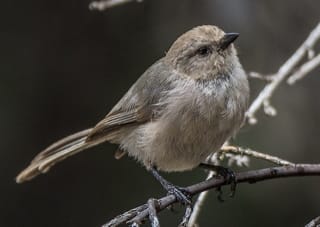 Photo: male by Betsy Matsubara 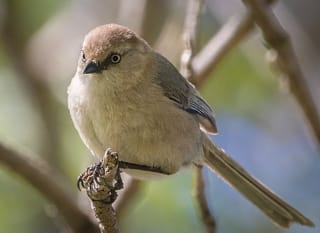 Photo: female by Betsy Matsubara 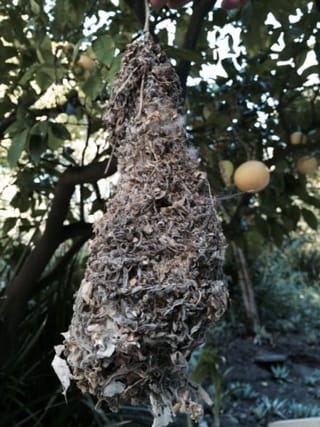 Photo: nest by Ryan J. Daniels |  Bushtit, American Bushtit; Least TitmouseBUSH (Psaltriparus minimus)Family: Aegithalidae (Bushtits) Size: 3.8 - 4 in (10 - 10 cm) Flies: Jan 01 - Dec 31 Morphology: both sexes are similar with gray and brown plumage; males have a dark rim around the eye while females have a yellow one Status: native; common Food source: wide variety of tiny insects, insect eggs, spiders, berries and some seeds Habitat: deciduous growth, chaparral, pinyon-juniper and pine-oak woods The American Bushtit is the smallest passerine bird in North America. These birds are very sociable, particularly in winter when they form flocks and will even huddle together on cold nights. They are most often seen congregating in trees or at feeders in large groups. When ready to move on, they tend to fly off one at a time and may perform acrobatic stunts. Bushtits tend to forage in flocks except when nesting. They probe at the base of leaves or needles for insects. Bushtit nests are hang down from a branch and are made of moss and lichen held together with spider silk and lined with feathers. Both parents incubate and fed the young (eggs hatch in about 12 days, young fledge in approximately 2 weeks; typically 2 broods per year). Info Photos Distribution Frequency |
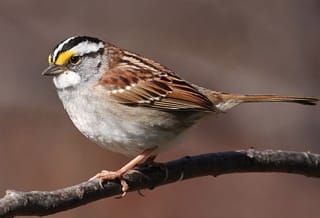 Photo: white-striped variation by Cephas 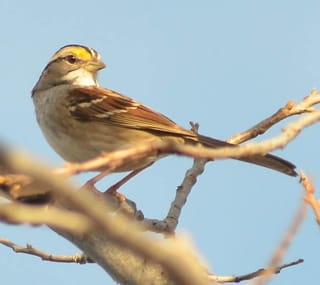 Photo: tan-striped variant by Roberto R. Calderón |  White-throated Sparrow, Cherry-birdZONALB (Zonotrichia albicollis)Family: Emberizidae (New World Sparrows and Allies) Size: 5.9 - 7.5 in (15 - 19 cm) Flies: Mar 15 - May 15 and Oct 15 - Dec 31 Morphology: sexes are similar with brown above, grayish-brown underneath and a white throat; the white-striped variant has a black-and-white-striped head with yellow between the eye and the bill; the tan-striped variant has a brown-and-buff face pattern Status: native; uncommon Food source: insects, seeds and berries; feeds young mostly insects Habitat: thickets, brush, undergrowth of conifer and mixed woodlands The White-throated Sparrow generally forages on the ground under or close to dense cover and may scratch in leaf letter. This sparrow sings with a clear whistle. It usually nests on the ground in a well hidden spot but may nest above ground in a low tree. The nest is open cup-shaped made of twigs, grass, weeds, etc. The female typically lays 4 to 5 pale blue or greenish blue eggs marked with reddish brown and lavender. The eggs usually hatch in a little more than a week. Both parents then tend the hatchlings for at least 2 more weeks. There can be more than one brood per season. Info Photos Distribution Frequency |
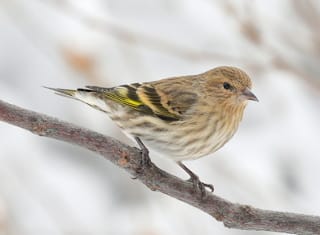 Photo: male by Bob Walker 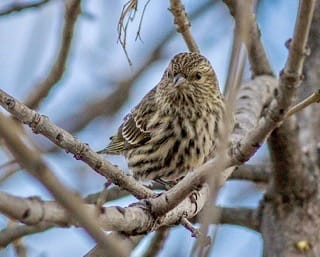 Photo: female by Mouser Williams 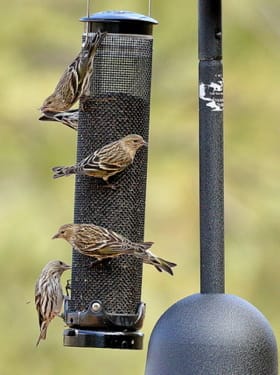 Photo: raiding thistle feeder by Bob Walker |  Pine Siskin, Pine LinnetPISI (Carduelis pinus, Spinus pinus)Family: Fringillidae (Finches) Size: 4.5 - 5 in (11 - 13 cm) Flies: Jan 01 - Dec 31 Morphology: males are grayish brown with brown striping and yellow edges on both wings and tail; females are more brownish with much less yellow Status: native; common Food source: mostly seeds and other vegetable matter; some insects; may eat flower parts and young shoots Habitat: mixed woodlands, thickets, brushy pastures Although Pine Siskins are patterned like sparrows, their overall behavior emphasizes that they are related to goldfinches. They actively forage for seeds in trees and shrubs and can spend all day at a thistle feeder. Pine Siskins are an irruptive species meaning that they can have an irregular migration pattern, i.e., large flocks of these birds are sometimes observed in unexpected areas. Pine Siskins may nest in loose colonies or isolated pairs. Cup-shaped nests are usually well hidden in a conifer. Incubation time is about 2 weeks with the young leaving the nest 2 weeks later. Info Photos Distribution Frequency Featured |
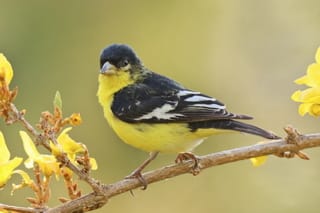 Photo: male, Eastern variant by Bob Walker 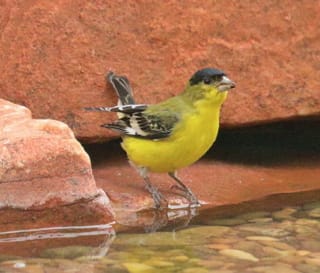 Photo: male, Western variant by Bob Walker 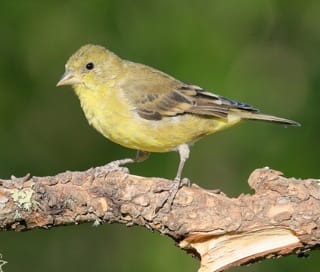 Photo: female by Bob Walker |  Lesser Goldfinch, Arkansas GoldfinchLEGO (Carduelis psaltria, Spinus psaltria)Family: Fringillidae (Finches) Size: 3.5 - 4 in (9 - 10 cm) Flies: Jan 01 - Dec 31 Morphology: breeding males are bright yellow with black forehead, black wings with white markings, and white patches around the tail; Eastern variant has a black back, whereas the Western variant has an olive back; breeding females are dull yellow beneath and olive above; nonbreeding birds are drab brown with blackish wings and pale wing bars Status: native; locally common Food source: mostly eats seeds, in particular composites such as thistle and sunflower; will also feed on flowers, buds, and berries as well as some small insects Habitat: open brushy country, open woods, wooded streams, gardens The Lesser Goldfinch is a common summer visitor that is attracted to feeders, hanging around all day if there is thistle seed present. These birds remain in flocks, except when nesting, actively moving through trees, shrubs, and weeds in search of food. In the warmer parts of the Southwest breeding may extend from early spring to mid-autumn. Open cup nests are build on a vertical fork in a shrub or tree fairly high above the ground. Incubation time is about 12 days. However, the time it takes for the young to leave the nest is not known. There are usually two and sometime three broods per year. Info Photos Distribution Frequency |
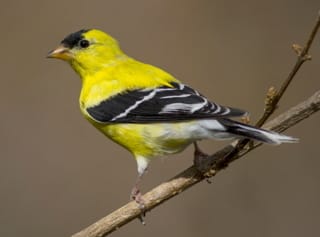 Photo: breeding male by Mouser Williams 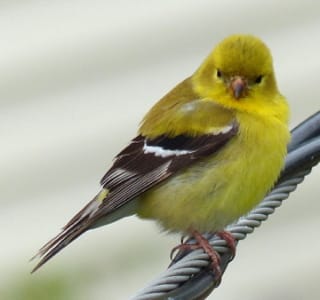 Photo: breeding female by molanic 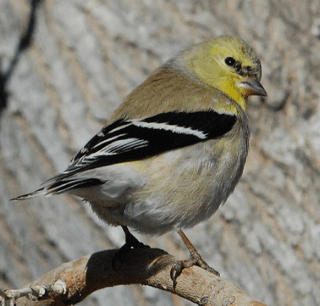 Photo: nonbreeding adult by Jerry Oldenettel |  American Goldfinch, Black-winged Yellow BirdAMGO (Carduelis tristis, Spinus tristis)Family: Fringillidae (Finches) Size: 4.5 - 5 in (11 - 13 cm) Flies: Jan 01 - Dec 31 Morphology: breeding males are bright yellow with black forehead, black wings with white markings, and white rump; breeding females are dull yellow beneath and olive above; non breeding birds of both sexes are drab brown overall with black wings and dark beak Status: native; uncommon Food source: primarily small seeds but will feed on some insects in summer Habitat: brushy thickets, weedy grasslands The American Goldfinch can be seen year-round in the area. This is in contrast to the Lesser Goldfinch which is only a summer visitor. The American Goldfinch actively forages in weeds and shrubs and will climb up into plants such as thistle to reach the seeds. They can be seen at feeders. Nesting occurs in July and August. The cup-like nest is very compact, usually located high above the ground on a horizontal or upright fork of a tree. The young hatch about two weeks after the eggs are laid. Both parents feed the young until they leave the nest at about 11 to 17 days old. Info Photos Distribution Frequency |
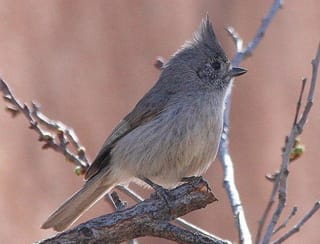 Photo: adult by J.N. Stuart 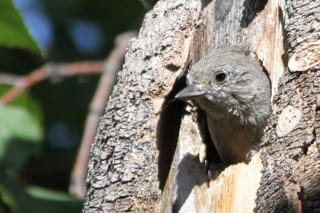 Photo: adult by David Yeamans  Photo: fledgling by Bob Walker |  Juniper TitmouseJUTI (Baeolophus ridgwayi, Baeolophus griseus)Family: Paridae (Chickadees and Titmice) Size: 5.8 in (15 cm) Flies: Jan 01 - Dec 31 Morphology: both males and females have gray bodies, paler bellies, dark eyes, short bill, and pointed crest Status: native; common Food source: mainly insects and some spiders but also eats nuts and seeds Habitat: pinyon-juniper woodland, oak or pine woodlands Juniper Titmice will come to bird feeders but can often be seen hopping around on tree branches hunting for food. Sometimes they will even hang upside down while searching for insects. In addition, they are capable of opening nuts and acorns by pounding them with their bills while holding the nuts with their feet. During winter, titmice tend to congregate into roaming groups. Nests are usually located in a hole or some other type of natural cavity in a tree. However, Juniper Titmice will also use nest boxes. The nest is filled with grass, weeds, and other fibers and then lined with feathers or animal hair. Females are responsible for the incubation of the eggs which hatch in a little over 2 weeks. Both parents then fed the young until they leave the nest in another 2 to 3 weeks. Info Photos Distribution Frequency |
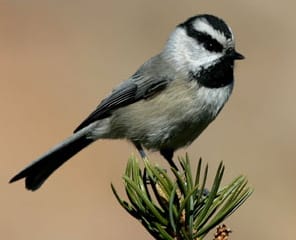 Photo: adult by Hari Viswanathan 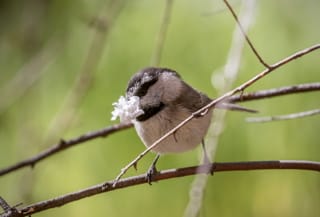 Photo: adult with nesting material by Mouser Williams |  Mountain ChickadeeMOCH (Poecile gambeli, Parus gambeli)Family: Paridae (Chickadees and Titmice) Size: 5 - 5.8 in (13 - 15 cm) Flies: Jan 01 - Dec 31 Morphology: black cap and bib with white cheeks and grey sides; only chickadee with a white eye stripe Status: native; common Food source: mostly insects such as caterpillars and beetles but also seeds and berries Habitat: mountain forests, conifer forests Chickadees are small birds with large heads that often hang upside down to pluck small insects from conifer needles. These birds are fearless, inquisitive, and constantly foraging. They are attracted by oil sunflower seeds, suet, peanuts and peanut butter to feeders. They live at high altitudes in the summer but descend to lowlands in the winter. Females lay 7 to 9 white or lightly spotted eggs in a hair- or fur-lined natural cavity or woodpecker hole. Eggs hatch in about 14 days. Young fledge around 3 weeks of age. Info Photos Distribution Frequency Featured |
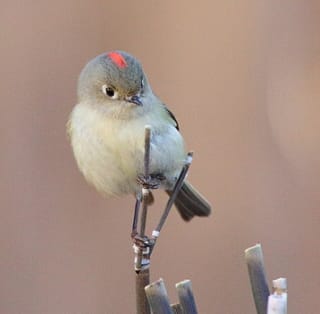 Photo: male with crown slightly visible by Bob Walker 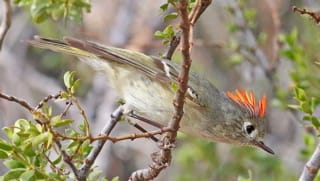 Photo: male with crown erect by Jerry Oldenettel 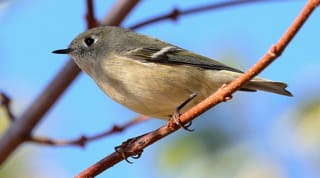 Photo: adult by Bob Walker |  Ruby-crowned KingletRCKI (Regulus calendula, Corthylio calendula)Family: Regulidae (Kinglets) Size: 3.8 - 4.5 in (10 - 11 cm) Flies: Jan 01 - Dec 31 Morphology: adults are olive-green with a white eyeing, black and white wingbars, thin tail, and small beak; males have a red crown which is most visible when the bird raises its head feathers Status: native; common Food source: whatever insects are most readily available for the given season; also eats some berries, seeds, sap, and potentially nectar Habitat: deciduous and coniferous forests, thickets Ruby-crowned Kinglets live high in conifers during summer and, as such, are often hard to see. During the colder months, these tiny birds are potentially more visible as they flit about closer to the ground. They will most often perch on branches and twigs examining foliage for food. However, they can hover while foraging and may even fly out to catch an insect mid-air. During courtship, the male sings and raises its crown feathers to attract a female. The female builds a deep cup nest high up in a tree where it is protected by foliage from above. There are usually 7 to 8 eggs that are incubated for two weeks. The young usually leave the nest about 16 days later. Info Photos Distribution Frequency |
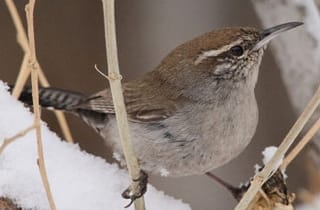 Photo: adult by Bob Walker 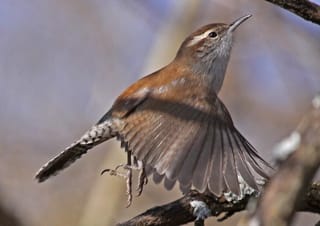 Photo: adult by Jerry Oldenettel |  Bewick's Wren, Mocking WrenBEWR (Thryomanes bewickii)Family: Troglodytidae (Wrens) Size: 5.5 in (14 cm) Flies: Jan 01 - Dec 31 Morphology: males and females look similar; medium-sized body with long, barred tail that is tipped with white and held upright; brown on top and grey on the bottom with a white stripe over the brow Status: native; common Food source: eats a variety of insects, including beetles, ants, caterpillars, and grasshoppers; also eats spiders, some berries, and some seeds Habitat: thickets, brush piles, hedgerows, open woodlands, scrubby areas Bewick’s Wrens are most often seen climbing and hopping along tree branches or exploring in leaf litter. They are known for waving their tails about and making harsh noises if disturbed. These birds nest in any kind of cavity, either natural or manmade, including nest boxes. Males build “dummy” incomplete nests to attract the females. The female then choses a site and competes the nest by lining it with various materials. Eggs hatch is about 2 weeks with the young leaving the nest around 2 weeks later. Info Photos Range Frequency |
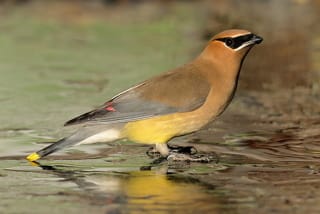 Photo: adult by Bob Walker  Photo: adult by J.N. Stuart 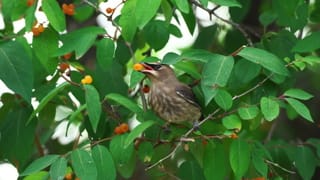 Photo: immature by Paul Tavares |  Cedar WaxwingCEDW (Bombycilla cedrorum, Ampelis cedrorum)Family: Bombycillidae (Waxwings) Size: 6.5 - 8 in (17 - 20 cm) Flies: Jan 01 - Dec 31 Morphology: adults of both sexes have a crest (often flopped over) and are brown on the head and back, yellow on the belly, and gray on the wings and tail; in addition, the face has a narrow black mask, the tail a bright yellow tip, and the wings waxy red tips which are often hidden; immatures are fairly similar to the adults but with a mottled breast Status: native; uncommon Food source: mostly berries and insects Habitat: open woodlands ,orchards,residential areas Cedar Waxwings are seen in the area during the non-breeding season when they typically forage in flocks. They will sit in fruit trees devouring berries or hovering briefly nearby plucking fruit off of the trees. They will also take insects off of the foliage and may catch others in mid-air. Waxwings will come to a bird bath or other water source. Nesting usually does not occur until mid-summer and may take place in small colonies. Nests have a loosely build, open-cup structure. Under normal conditions, there are two broods per year. Info Photos Distribution Frequency |
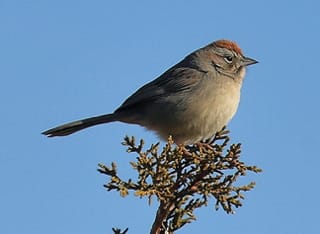 Photo: adult by Bob Walker 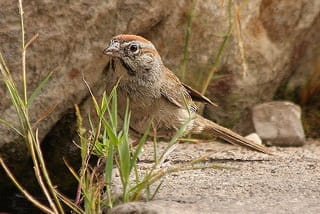 Photo: adult by J.N.Stuart |  Rufous-crowned Sparrow, Boucard's Summer FinchRCSP (Aimophila ruficeps)Family: Emberizidae (New World Sparrows and Allies) Size: 5 - 6 in (13 - 15 cm) Flies: Jan 01 - Dec 31 Morphology: large, gray sparrow with streaked back, reddish-brown crown, white eyering, and white stripes edged in black on the throat Status: native; uncommon Food source: varies with the season with insects in summer, seeds in winter Habitat: open oak woodlands, dry uplands Rufous-crowned Sparrows usually live in dense cover, skulking around on rocky, brushy hillsides and in canyons. However, they are not particularly shy and can be observed closely if left undisturbed. Pairs or family groups tend to forage together. They hop along the ground or feed in low bushes. Nests are usually well hidden on the ground. The young leave the nest before they are able to fly and may stay with their parents for up to several months after that. Info Photos Distribution Frequency |
 Photo: Oregon variant by Jonathan Creel 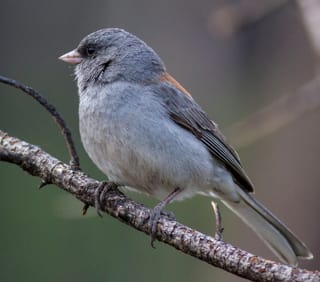 Photo: grey-headed variant by Mouser Williams  Photo: pink-sided variant by Mouser Williams |  Dark-eyed JuncoDEJU (Junco hyemalis)Family: Emberizidae (New World Sparrows and Allies) Size: 5 - 6.3 in (13 - 16 cm) Flies: Jan 01 - Dec 31 Morphology: both sexes are generally dark gray or brown with a pink bill and white outer tail feathers; there is a large range of geographical variation in color with the Oregon, white-winged, pink-sided, and grey-headed variations found in the local area Status: native; common Food source: mostly feeds on seeds and grasses with occasional small fruits and insects; young primarily fed insects Habitat: open forests, mixed woods, fields, parks, gardens Dark-Eye Juncos are lively territorial birds that are commonly called “snowbirds” because they are a herald of winter. They are often seen feeding on snow-covered berry bushes and grasses. They travel in flocks with one leader. Dark-eyed Juncos mostly forage on the ground, often under a feeding tray. They particularly enjoy gardens that have gone to seed with water nearby. Open cup-shaped nests are usually found on the ground hidden under things like overhanging grass or exposed roots. These birds may have multiple broods per year with incubation time being about 2 weeks. The young usually leave the nest about 2 weeks after hatching. Info Photos Distribution Frequency Featured |
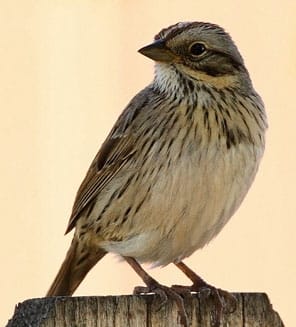 Photo: adult by Bob Walker 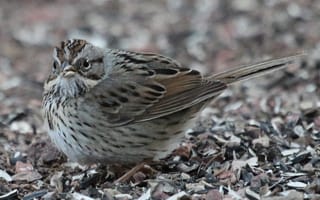 Photo: adult by David Yeamans  Photo: adult by Mouser Williams |  Lincoln's Sparrow, Lincoln's FinchLISP (Melospiza lincolnii)Family: Emberizidae (New World Sparrows and Allies) Size: 5 - 6 in (13 - 15 cm) Flies: Jan 01 - Dec 31 Morphology: both sexes have streaky brown/gray wings and tail with rusty edges, buff underparts with black streaking, white belly, buffy mustache stripe bordered by thin brown lines, dark eyering, and brown and black stripped crown with a central gray stripe; note: the head may look crested when the crown feathers are raised Status: native; locally common Food source: primarily seeds with some insects; young fed entirely on insects Habitat: brushy bogs, thickets Lincoln’s Sparrows which resemble Song Sparrows are normally secretive. They often skulk in dense, low cover and can be found hiding in bushes by their distinctive call. These birds are solitary, rarely seen as part of a flock. They forage by hopping on the ground, most often under dense bushes or grasses. They will come to well-watered yards. Males defend their nesting territory by singing. Open cup nests of grasses are build on the ground by the females. They nests are well hidden by dense greenery. Info Photos Range Frequency |
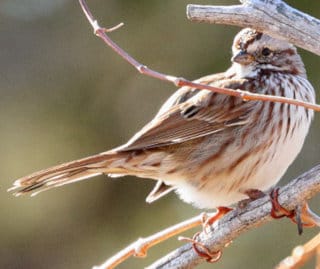 Photo: adult by Bob Walker 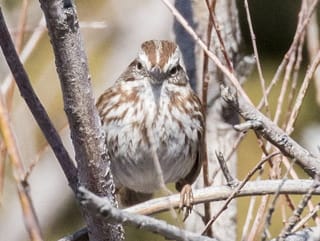 Photo: adult by Mouser Williams |  Song SparrowSOSP (Melospiza melodia, Melospiza cinerea)Family: Emberizidae (New World Sparrows and Allies) Size: 5 - 7 in (13 - 18 cm) Flies: Jan 01 - Dec 31 Morphology: both sexes have thick, brown streaks on a white chest and flanks along with reddish-brown and gray streaks on the head; birds in the Southwest are paler than in other parts of the country Status: native; uncommon Food source: eats a variety of insects and spiders in summer and mainly seeds in winter Habitat: edges of forests, clearings, thickets open grassy marshes, gardens Typical location: White Rock Wastewater Treatment Plant The Song Sparrow is one of the most widespread and variable of North American birds. Song Sparrows live up to their name by singing constantly throughout the spring and summer. They are usually conspicuous by their sheer numbers. These birds usually forage on the ground but will readily come to feeders, often as part of a mixed flock with other sparrows. Males will defend small nesting territories. Open-cup nests may be located on the ground under cover or low in a tree. Info Photos Distribution Frequency |
 Photo: male by Gowri Srinivasan 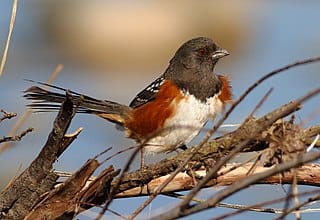 Photo: female by ADJ82 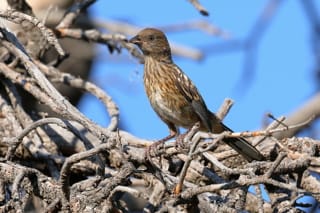 Photo: immature by Bob Walker |  Spotted TowheeSPTO (Pipilo maculatus)Family: Emberizidae (New World Sparrows and Allies) Size: 7 - 8.5 in (18 - 22 cm) Flies: Jan 01 - Dec 31 Morphology: adult males have white breast and rufous sides along with black head, throat, tail, and back/wings with white spots; adult females are the same but with dark brown where the males are black; immatures are streaked brown overall Status: native; common Food source: eats insects, seeds, and berries with diet varying with season Habitat: forest edges, thickets, woodlands, parks Once thought to be a variant of the Rufous-sided Towhee, the Spotted Towhee is now considered to be a separate species. Towhees are ground feeders, preferring to be near a thicket or in the underbrush. They are often first noticed because of the sound of their loud scratching while rummaging in leaf-litter for insects or for seeds at platform feeder. Their distinctive movements have been described as the “Towhee Shuffle”. Nests are typically located on the ground under a shrub or in a low bush and are of an open-cup design. Incubation time is about 2 weeks. The young leave the nest 9 to 11 days later. There are usually one to two broods per year and on rare occasions three. Info Photos Distribution Frequency Featured |
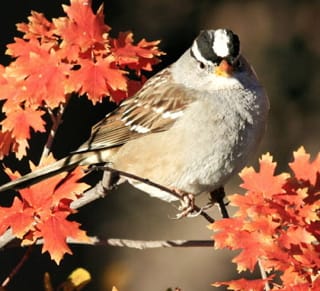 Photo: adult by Hari Viswanathan 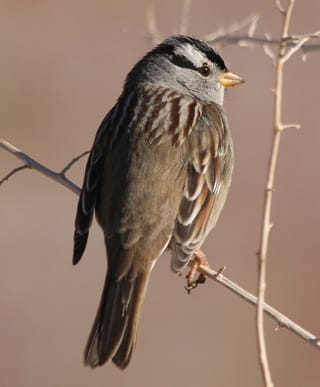 Photo: adult by J.N. Stuart 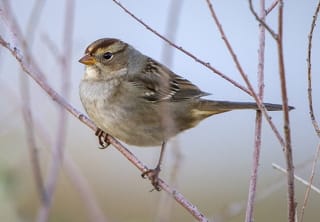 Photo: immature by Mouser Williams |  White-crowned SparrowWCSP (Zonotrichia leucophrys, Spizella leucophrys)Family: Emberizidae (New World Sparrows and Allies) Size: 6 - 7.5 in (15 - 19 cm) Flies: Sep 01 - Jun 01 Morphology: adults mostly pale-gray with bold black-and-white stripes on the head and pink or yellow bill; immatures are like adults but with brown-and-gray stripes on head rather than black-and-white Status: native; locally common Food source: mostly seeds, insects, and other vegetable matter such as buds, flowers, and berries; young mostly fed insects Habitat: open grasslands, open woods Typical location: Overlook Park, The Stables Much of what we know about the physiology of bird migration has been learned from laboratory experiments with the White-crowned Sparrow. These sparrows usually forage while running along the ground and hopping from place to place. They typically forage in flocks except during nesting season. White-crowned Sparrows will come to platform feeders in the winter. Males typically migrate to the nesting ground in the north before the females. There they defend territories by singing. Males learn songs from the area in which they are raised. This has lead to local song dialects and even bilingual areas on the border between two dialects. Info Photos Distribution Frequency |
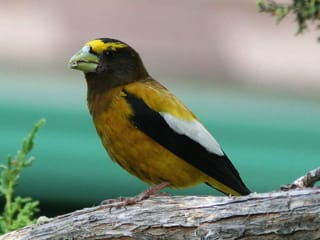 Photo: male by Hari Viswanathan 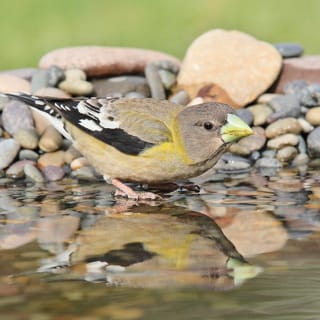 Photo: female by Bob Walker 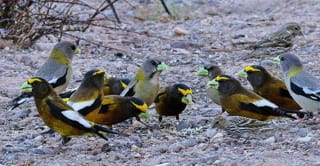 Photo: mixed flock by bob Walker |  Evening GrosbeakEVGR (Coccothraustes vespertina, Hesperiphona vespertina)Family: Fringillidae (Cardinals, Grosbecks, and Allies) Size: 7.5 - 8.5 in (19 - 22 cm) Flies: Jan 01 - Dec 31 Morphology: heavyset birds with thick, conical bills; males are yellow and black and have a white patch on the wings, dark heads, bright-yellow stripe over eye, and pale ivory to greenish bill; females are primarily gray and have black and white wings, a greenish tinge to neck and flanks, and a greenish-yellow bill; immatures like females Status: native; locally common Food source: mostly seeds, some berries, buds and sap, occasional insects Habitat: coniferous forests, deciduous woodlands, suburban areas The Evening Grosbeak is a western bird that has expanded its range as far east as New England. Locally, they may be common one year and uncommon the next. These birds are very fond of sunflower seeds which they can easily crack with their large bills. Flocks will readily visit bird feeders to consume large amount of the seeds. They have been observed to eat almost 100 sunflower seeds in five minutes. Evening Grosbeaks will also consume a surprising quantity of raw salt. During mating season, the birds leave the flock to pair up. Males will perform a courtship dance. The nest, built by the female, consists of a loosely made cup of twigs and is usually located on branch well out from the trunk. Info Photos Distribution Frequency |
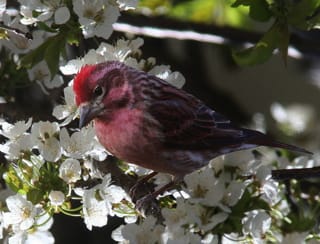 Photo: male by Hari Viswanathan 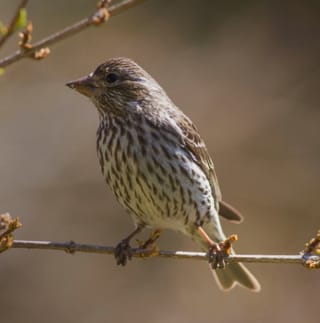 Photo: female by Mouser Williams |  Cassin's FinchCAFI (Haemorhous cassinii, Carpodacus cassinii)Family: Fringillidae (Finches) Size: 6 - 6.5 in (15 - 17 cm) Flies: Jan 01 - Dec 31 Morphology: both sexes have thin white eye rings, notched tails, and long wings; males have a deep red crown and a rosy pink wash over the rest of the body; females are brown-and-white with dark streaks on the chest and underparts; immatures look like the females Status: native; locally common Food source: mostly eats vegetable matter (seeds, buds, berries, and fruits); occasionally eats insects in summer Habitat: open conifer stands Cassin’s Finches are common in the local area in spring and fall but uncommon in summer. These birds often forage in small roving flocks, feeding high up in trees, in weedy growth on the ground, or at bird feeders. Cassin’s Finches crave salt and may be seen visiting mineral deposits on the ground. Males retain their female-like plumage during their first breeding season. However, they will sing, giving the impression that both sexes sing. The complicated song of a male often includes imitations of other birds. Cassin’s Finches may nest in small colonies using open-cup nests located fairly high up in the trees. The number of breeding pairs in an area can vary from year-to-year. Info Photos Range Frequency |
 Photo: male by Mouser Williams 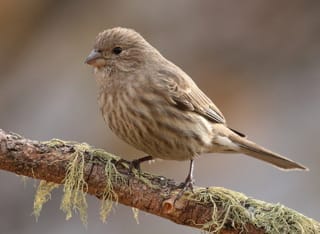 Photo: female 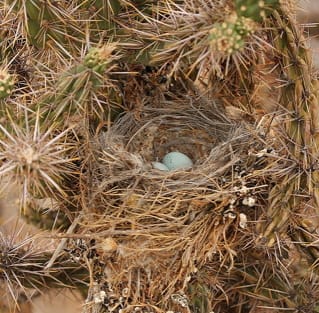 Photo: nest by J.N. Stuart |  House FinchHOFI (Haemorhous mexicanus, Carpodacus mexicanus)Family: Fringillidae (Finches) Size: 5 - 6 in (13 - 15 cm) Flies: Jan 01 - Dec 31 Status: native; common Habitat: chaparral, deserts, orchards House Finches are native to the Southwest but were released in New York during the 1940s and have subsequently expanded in such a way as to be found coast-to-coast. These finches will forage on the ground or while perching up in a shrub or tree. They typically forage in flocks except when nesting. They will visit feeders in large numbers. However, some consider them to be pests since they are susceptible to infections that can be spread to other feeder visitors. Males may sing anytime during the year but females only sing during spring. During breeding season, males will perform a flight-song display. Open cup nests can be found in a variety of locations including in trees, holes in man-made structures, hanging planters, and old nests of other birds. House Finches can have up to three broods per year. Info Photos Distribution Frequency Featured |
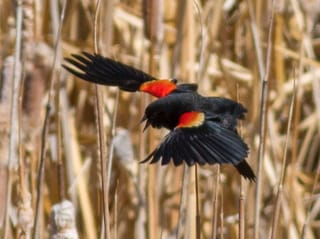 Photo: male by Mouser Williams  Photo: female by Mouser Williams  Photo: immature male by Bob Walker |  Red-winged BlackbirdRWBL (Agelaius phoeniceus)Family: Icteridae (Blackbirds and Orioles) Size: 7 - 9.5 in (18 - 24 cm) Flies: Jan 01 - Dec 31 Morphology: males are glossy black overall except for a red shoulder patch with a yellow border; females are brown with dark streaks and a buff-colored throat; immature males are black with buff or orange on the edges of their feathers and may show the beginning of shoulder patches Status: native; locally common Food source: mostly insects and seeds, some berries Habitat: marshes, wet meadows, pastures Typical location: Big Rock Loop, The Stables Red-winged Blackbirds are seen in the area during spring, summer, and fall. Outside of breeding season, they can be found foraging in small flocks, often with other large birds. In the southern part of the state, they congregate in much larger groups. Red-winged Blackbirds usually forage while walking along on the ground, though sometimes they will go up shrubs or trees. Males will defend their territory and attract a mate by perching on a high stalk, fluffing their feathers, and singing. Nests are a bulky open cups that are placed among dense bushes or grasses. The eggs are incubated for 10 to 12 days. Young leave the nest about 2 weeks after hatching. Info Photos Distribution Frequency |
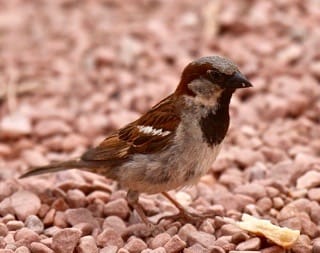 Photo: male by Lonny Holmes 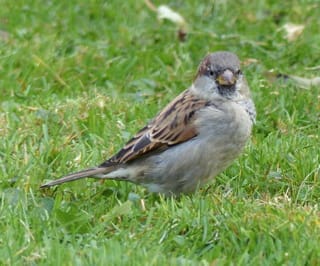 Photo: non-breeding male by molanic 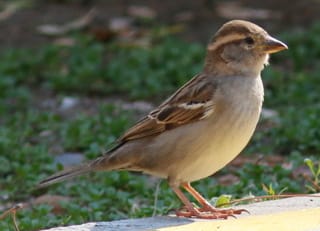 Photo: female by Alison Sheehey |  House Sparrow, English SparrowHOSP (Passer domesticus)Family: Passeridae (Old World Sparrows and Allies) Size: 5 - 6.5 in (13 - 17 cm) Flies: Jan 01 - Dec 31 Morphology: breeding males are brightly colored with gray crowns, white cheeks, black bibs, rusty necks, and black beaks; non-breeding males have more subdued colors including that on the neck — they also have a smaller black bib and a yellow rather than black beak; females are buffy-brown overall with gray-brown underparts and back stripes of buff, black, and brown Status: introduced; common Food source: mostly weed, grass, and waste seeds; some insects and scavenged food crumbs left by humans Habitat: cities, towns, agricultural areas House Sparrows are not related to New World sparrows. Rather they are native to Eurasia and northern Africa.They were introduced into Brooklyn, NY in 1851 and rapidly spread across all of North America except the far north. These birds are aggressive and can survive in areas inhospitable to other birds such as in cities, where they have greatly benefited from their association with humans. House Sparrows primarily forage by hopping on the ground, looking for seeds and other scraps. They will even take smashed insects off of parked cars and come to feeders. Nests are made from a variety of materials and are usually located in a cavity either natural or man-made. Young leave the nest 2 weeks after hatching. There are typically 2 to 3 broods per year. Info Photos Distribution Frequency |
 Photo: breeding adult by Bob Walker 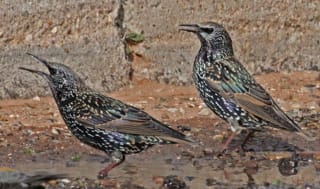 Photo: nonbreeding adult by Jerry Oldenettel 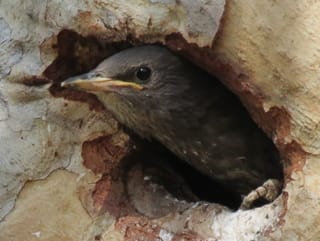 Photo: immature by Chris Mallory |  European Starling, Common StarlingEUST (Sturnus vulgaris)Family: Sturnidae (Starlings and Mynas) Size: 7.5 - 8.2 in (19 - 21 cm) Flies: Jan 01 - Dec 31 Morphology: adults are glossy black overall with a purplish-green iridescence; breeding individuals have pale white spots on the back and a yellow bill, whereas nonbreeding birds have bright white spots all over and generally a black bill; immatures are dull grayish brown with a black bill Status: introduced; locally common Food source: quite varied diet, consisting of mostly insects, berries, and seeds with occasional worms and other invertebrates Habitat: cities,suburban areas,farmlands,ranches Typical location: The Stables European Starlings were introduced to North American in 1890 and have spread to most of the continent. Their common name comes from that fact that in flight they look like to a small, four-pointed star. European Starlings are sociable birds, particularly outside of breeding season when they form large flocks. They mostly forage on the ground in open areas walking around with a characteristic swagger. These birds will nest in any kind of cavity whether natural or man-made. The nest, itself, is a mass of twigs, grass, leaves, etc. Starlings have two broods per year. The eggs hatch in about a week and half and the young leave the nest approximately 3 weeks later. Info Photos Distribution Frequency |
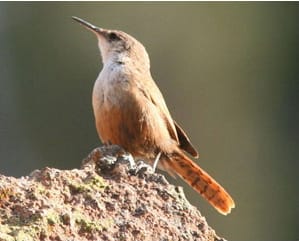 Photo: adult by Hari Viswanathan 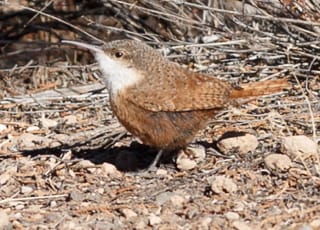 Photo: adult by Stephen Shankland 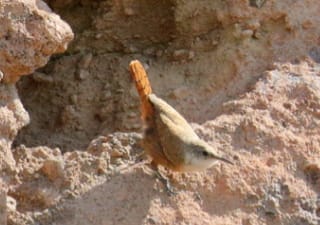 Photo: adult by Bob Walker |  Canyon Wren, Dotted WrenCANW (Catherpes mexicanus)Family: Troglodytidae (Wrens) Size: 5.5 - 6 in (14 - 15 cm) Flies: Jan 01 - Dec 31 Morphology: both sexes have brown body, white throat, bright rusty, barred tail, and long, thin bill curved downward; immatures are similar to adult but with less markings Status: native; locally common Food source: variety of insects including termites, ants, beetles, etc. and some spiders Habitat: rocky canyons, cliffs, old stone buildings Typical location: Falls Trail, White Rock Canyon Canyon Wrens are hyperactive, most often seen scurrying around the rocks. Their long bills and flat heads enable them to reach deep into crevices to find food. In addition to foraging under rocks and in crevices, these birds will explore areas with very dense undergrowth for prey. Canyon Wrens do not appear to drink water but get what they need from insects. Males defend the nesting area by singing. Nests, usually in a hole or rock crevice, are filled with coarse items topped with a cup made of softer materials. Young leave the nest at about 15 days of age, but will remain with their parens for several more weeks. Info Photos Distribution Frequency |
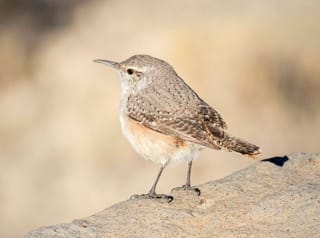 Photo: adult by Mouser Wlliams  Photo: adult by Bob Walker 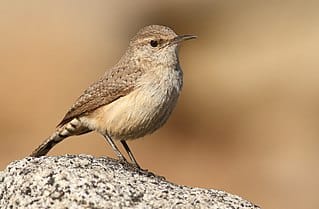 Photo: adults by ADJ82 |  Rock WrenROWR (Salpinctes obsoletus)Family: Troglodytidae (Wrens) Size: 5 - 6.5 in (13 - 17 cm) Flies: Jan 01 - Dec 31 Morphology: small, pale gray and brown birds with faintly striped throats, long, barred tails, and long, thin bills Status: native; uncommon Food source: mostly insects and spiders Habitat: rock-strewn slopes, canyons cliffs Rock Wrens usually forage on the ground, often probing in crevices among rocks. They are not known to drink water but get what moisture they need from their food. These birds can often be seen moving about and bouncing up and down on their short legs. Male Rock Wrens are incredible singers with a repertoire of a 100 or more songs learned from other birds. Nest sites are in sheltered areas such as under a rock ledge or a crevice in a building. There is often a walkway of small pebbles, bones, or other debris leading up to the nest cavity. The function of this “patio” is unknown. Info Photos Distribution Frequency |
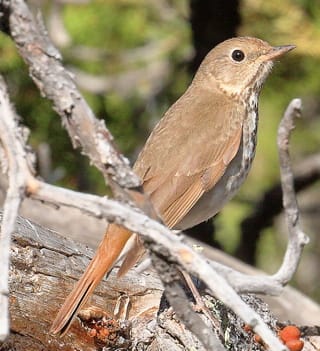 Photo: adult by Bob Walker  Photo: adult by Mouser Williams 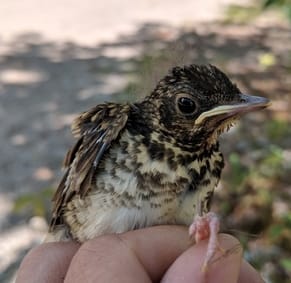 Photo: immature by nsharp |  Hermit Thrush, Swamp AngelHETH (Catharus guttatus, Hylocichla aonalaschkae)Family: Turdidae (Thrushes) Size: 6.5 - 7.5 in (17 - 19 cm) Flies: Jan 01 - Dec 31 Morphology: adults are brown on the head and back with pale underparts, distinctive spots on the throat and breast, a reddish tail, and a thin white eyering; immatures are gray-brown above with spotting on back and wings Status: native; locally common Food source: feeds on insects, spiders, worms, and berries Habitat: mixed forests, deciduous woodlands, thickets Hermit Thrush are seen primarily during the spring and fall migration, but may also spend the summer in the area. These birds tend to migrate earlier in spring and later in fall than other thrushes. If surprised, a Hermit Thrush may stare at the onlooker while flicking its wings and moving its tail up and down. These thrush are attracted to water gardens where they hop around the shrubs nearby. They pick up food from the ground or off of the foliage in shrubs and trees. Nests in the west tend to be up in a conifer and made of a variety of plant materials including pine needles. Info Photos Distribution Frequency |
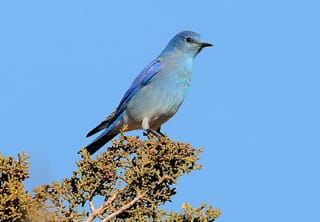 Photo: male by Bob Walker  Photo: male by Mouser Williams 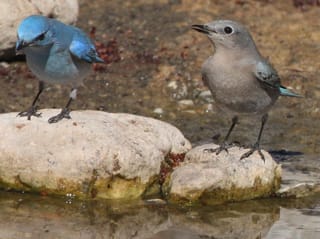 Photo: male and female by J.N. Stuart |  Mountain BluebirdMOBL (Sialia currucoides)Family: Turdidae (Thrushes) Size: 7 in (18 cm) Flies: Jan 01 - Dec 31 Morphology: males are sky-blue on top and paler underneath with dark blue on wings and tail; females are mostly gray brown with pale blue in the wings and tail; immatures look like spotted females Status: native; locally common Food source: mostly feeds on insects, such as beetles, grasshoppers, caterpillars, etc.; also eats berries, including mistletoe and juniper Habitat: high mountain meadows, plains, grassy areas Typical location: Bandelier Entrance Road, The Stables, Valle Grande Mountain Bluebirds often forage by hovering a few feet over an open field and then dropping to the ground to pick up insects. Alternatively, they may perch on a low branch and dart out to catch prey. Nests consist of a loose cup built in a cavity or hallow. Mountain Bluebirds will use nesting boxes which provide a great opportunity to watch these birds raise their young. Info Photos Distribution Frequency |
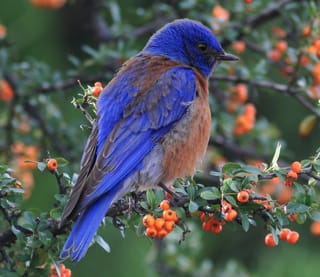 Photo: male by Hari Viswanathan 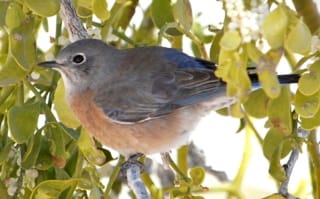 Photo: female by Jerry Oldenettel 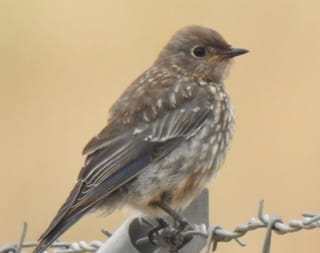 Photo: immature by Patty Teague |  Western BluebirdWEBL (Sialia mexicana)Family: Turdidae (Thrushes) Size: 6 - 7 in (15 - 18 cm) Flies: Jan 01 - Dec 31 Morphology: stocky birds with short tails; males are blue above with a rusty orange vest on the breast and upper back, blue throat, and white belly; females are gray with pale orange wash on the breast and bluish tint to the wings and tail, and white belly Status: native; common Food source: mostly insects (grasshoppers, caterpillars, beetles, and ants) with some berries and fruits (mistletoe, juniper, and elderberry) Habitat: open woodlands, pastures with old trees Western Bluebirds are most visible in the local area during winter and spring. They can most often when they fly down from a perch to pluck up insects from the ground. They will also catch insects in mid-air and will actively look for them among foliage. During winter, small flocks of Western Bluebirds may be seen feeding on berries in trees. Males typically stake out a nesting territory before courting a female. The nest site is in a cavity such as a tree hollow, old woodpecker nest, birdhouse, or hole in a building. Western Bluebirds have suffered by competition with European Starlings and House Sparrows for nesting sites. Info Photos Distribution Frequency Featured |
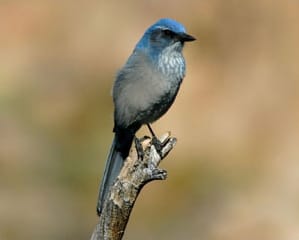 Photo: adult by Hari Viswanathan 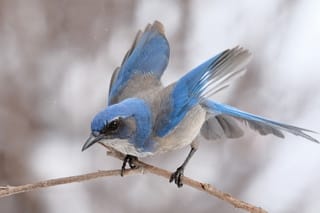 Photo: adult by Bob Walker 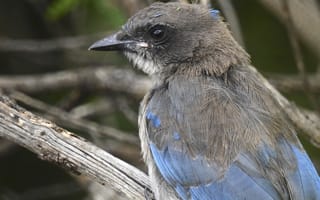 Photo: immature by antoniolp |  Woodhouse's Scrub-jay, Western Scrub JayWOSJ (Aphelocoma woodhouseii)Family: Corvidae (Jays, Magpies, and Crows) Size: 1 - 13 in (3 - 33 cm) Flies: Jan 01 - Dec 31 Morphology: both sexes are light blue and gray above with a a white throat, a gray breast, a partial blue band over the breast, and a long, pointed bill; chicks start out fully gray and get bluer as they get older Status: native; common Food source: diet varies with season from insects, spiders, and snails to seeds, acorns, nuts, and berries; may eat rodents, amphibians, eggs, and young birds of other species Habitat: scrub oak, woodlands, chaparral Woodhouse’s Scrub-Jays are nonmigratory birds named for Samuel W. Woodhouse who wrote about his Southwest expeditions between 1849 and 1852. They are often found in urban areas where they will come to platform and suet feeders. Typically these birds forage on the ground or in trees and will bury seeds and nuts for later retrieval. Scrub-jays are very intelligent, remembering the location and rate of decay of over 200 food caches. They will also steal food from other birds. Woodhouse’s Scrub-Jays breed as isolated pairs. Eggs are laid in a thick-walled cup-nest and hatch in a little less than 3 weeks. The young leave the nest about 3 weeks later. Info Photos Range Frequency Featured |
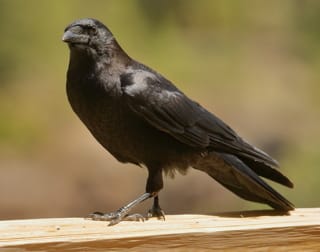 Photo: adult by Bob Walker 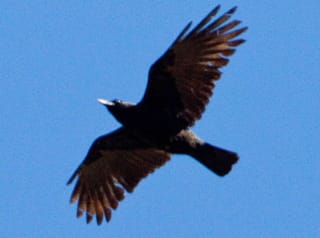 Photo: adult by B.J. Stacey 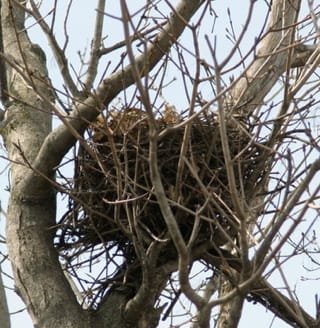 Photo: nest by Mike Leveille |  American CrowAMCR (Corvus brachyrhynchos, Corvus americanus)Family: Corvidae (Jays, Magpies, and Crows) Size: 17 - 21 in (43 - 53 cm) Flies: Jan 01 - Dec 31 Morphology: adults are entirely black including eyes, feathers are iridescent, tails are square-shaped, and wings are rounded; males are larger than females; immatures have blue eyes; note: crows are smaller in size and have thinner bills, sleeker feathers and a higher pitched voice than ravens Status: native; common Food source: omnivorous; insects, spiders, snails, earthworms, frogs, small snakes, shellfish, carrion, garbage, eggs, seeds, grain, berries, and fruit Habitat: deciduous growth along waterways, orchards, mixed evergreen woods, suburban and urban areas American Crows are common and widespread through the US having moved beyond farmlands into towns and cities. They are very intelligent and have survived several past extermination attempts. They are social, forming large community roosts in winter. A breeding pair may be helped by their offspring from previous seasons. Nests, a large basket of sticks and mud lined with soft materials, are built by both parents, usually in a crook of a large shrub or tree. Eggs are incubated, mostly by the female, for about 18 days. Both parents and sometimes “helpers” fed the chicks until they leave the nest in 4 to 5 weeks. Crows are susceptible to and may die from West Nile disease. Tracks Info Photos Distribution Frequency Featured |
 Photo: adult by Marion L. Stelts 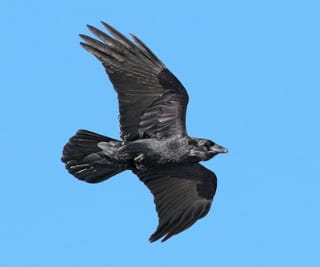 Photo: adult by Bob Walker 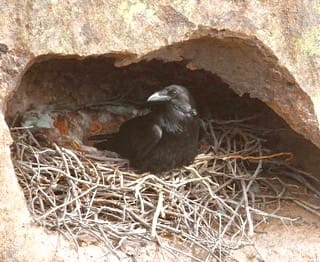 Photo: nest by Hari Viswanathan |  Common Raven, Northern RavenCORA (Corvus corax)Family: Corvidae (Jays, Magpies, and Crows) Size: 21 - 27 in (53 - 69 cm) Flies: Jan 01 - Dec 31 Morphology: adults entirely black including eyes, feathers are iridescent feathers, tails are wedge-shaped, and wings are pointed; immatures have blue eyes; note: ravens are larger in size and have thicker bills, shaggier feathers and a deeper voice than crows Status: native; common Food source: omnivorous; insects, rodents, lizards, frogs, eggs and young birds, carrion, and garbage Habitat: coniferous forests, deserts and mountain areas Common Ravens can be seen soaring in the skies everywhere in the local area. These birds are the largest of the passerines and are very intelligent with problem-solving and tool-using skills. In addition, they can mimic sound from their surroundings, including human speech. Immature ravens are very playful and can be observed doing things like sliding down snowbanks, apparently for fun. Ravens usually hunt in pairs in order to cooperate in flushing out prey. Nests which can be reused year after year are usually on a ledge or in a tall tree. Both parents help build the nest and feed the young which fledge about 5 to 6 weeks after hatching. Ravens are featured in the mythology of many Native American peoples. Tracks Info Photos Distribution Frequency Featured |
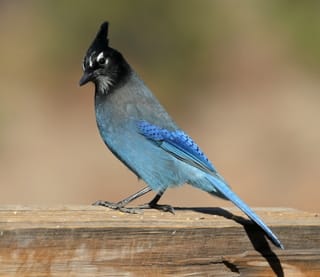 Photo: adult Rocky Mountain variant by Bob Walker 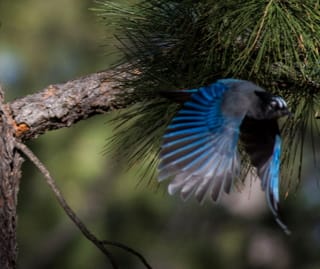 Photo: adult Rocky Mountain variant by Mouser Williams |  Steller's JaySTJA (Cyanocitta stelleri)Family: Corvidae (Jays, Magpies, and Crows) Size: 12 - 13.5 in (30 - 34 cm) Flies: Jan 01 - Dec 31 Morphology: large bird with rounded wings, crested head, long tail, dark blue body and black head; Rocky Mountain variant has white markings on the throat and above the eye Status: native; common Food source: seeds and nuts (especially in fall and winter), berries and fruits, insects (particularly in summer), and sometimes eggs, small rodents, and lizards Habitat: pine and oak forests Steller’s Jays are aggressive birds commonly found in Western conifer woods at low to moderate elevations. They can also be found in oak forests during the fall. Their staple food consists of conifer seeds and acorns which they often cache for later consumption. However, they are scavengers, often seen eating scraps in picnic areas and campgrounds. Steller’s Jays will visit feeders for sunflower seeds and peanuts. When not breeding, they typically live in flocks, often flying over an area in single-file. These birds are able to mimic the calls of other species, such as raptors, and can even imitate squirrels and household animals. Both sexes are very protective of their nest which consists of a ragged cup of weeds, etc., cemented together with mud. Incubation time is a little less than 3 weeks; age at first flight is not well known. Info Photos Range Frequency |
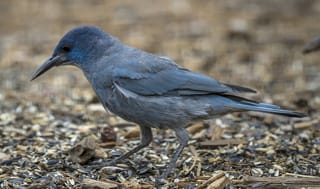 Photo: adult by Mouser Williams  Photo: small group of adults by Hari Viswanathan |  Pinyon JayPIJA (Gymnorhinus cyanocephalus, Cyanocephalus cyanocephalus)Family: Corvidae (Jays, Magpies, and Crows) Size: 9 - 11 in (23 - 28 cm) Flies: Jan 01 - Dec 31 Morphology: both sexes are dull blue with white chin, short tail, and long bill; immatures are similar to adult but duller in color Status: native; locally common Food source: seeds (especially those from the pinyon pine), fruits, insects, and sometimes eggs Habitat: ponderosa pine, pinyon-juniper, mixed pine oak forests Typical location: White Rock Spectacularly colorful and noisy flocks arrive in the summer. Pinyon Jays primarily forage on the ground but can clean out a bird feeder in no time. Flocks tend to follow the pinyon crop. They store the nuts in late summer and early fall by burying them in the ground for later retrieval. Social organization among these jays is complex with overall permanent flocks that can reach several hundred in size. The birds nest in colonies in cup-shaped nests found high up in juniper, oak, and pinyon trees. Incubation time is a little less than 3 weeks with the young leaving the nest about 3 weeks after that. Info Photos Distribution Frequency |
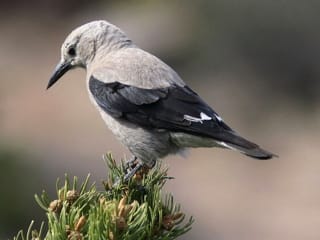 Photo: adult by Hari Viswanathan 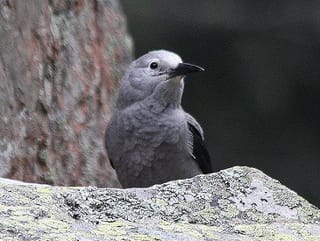 Photo: adult by J.N. Stuart 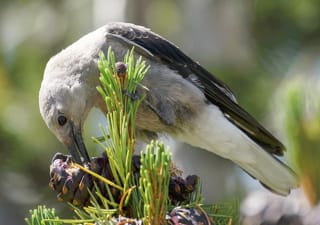 Photo: adult by Marshal Hedin |  Clark's Nutcracker, Meat BirdCLNU (Nucifraga columbiana)Family: Corvidae (Jays, Magpies, and Crows) Size: 12 - 13 in (30 - 33 cm) Flies: Jan 01 - Dec 31 Morphology: adults are ash gray overall with black wings, black tail with white on the sides, and black bill, legs, and feet; immatures look similar to parents but with bluer features Status: native; common Food source: diet primarily consists of pine seeds with the rest made up of other seeds, nuts, berries, insects, snails, and eggs Habitat: stands of juniper and ponderosa pine Clark’s Nutcrackers are fairly common in spring, summer, and fall, particularly in areas remote from human contact. However, they will fearlessly walk about in picnic grounds and parking lots looking for handouts. However, these birds are most talented at prying open pine cones to extract the seeds. They may temporarily store the seeds in a throat pouch until they can be added to a hidden cache for later consumption. These caches help support the birds during the breeding which can occur in late winter. Nests, located in a conifer on a horizontal branch, consist of a platform of twigs supporting a cup of grasses and bark strips. Both parents incubate the eggs and care for the young once they have hatched. The nestling usually leave the nest about 18 to 21 days after hatching. Info Photos Range Frequency |
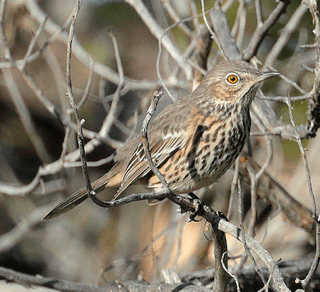 Photo: adult by Bob Walker 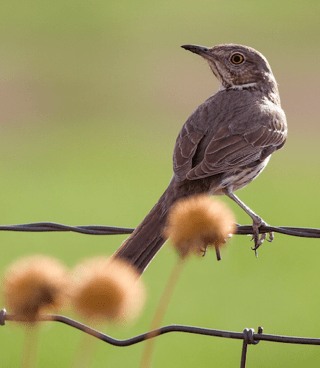 Photo: adult by Mouser Williams |  Sage ThrasherSATH (Oreoscoptes montanus)Family: Mimidae (Mockingbirds, Thrashers, and Allies) Size: 8.5 in (22 cm) Flies: Jan 01 - Dec 31 Morphology: both sexes are drab gray above with black spots on the breast, fine brown streaks on the flanks, white outer tail feathers, white wingbars, and large yellow eyes Status: native; uncommon Food source: eats mostly insects and berries plus some spiders and cultivated fruits Habitat: sagebrush plains, floors of rocky canyons, dense thickets The Sage Trasher is the smallest thrasher and is rather elusive. It will often run on the ground rather than fly if disturbed. These birds also forage by running around on open ground near areas with low shrubs. They will also perch in low trees and bushes to eat berries and will come to gardens for food. During breeding season, males will sing incessantly to defend a territory. Nests are typically located in sagebrush or other low bushes such as chamisa. Although cowbirds will lay eggs in a thrasher nest, the thrashers parents will toss them out. There may be 2 broods per year. Info Photos Distribution Frequency |
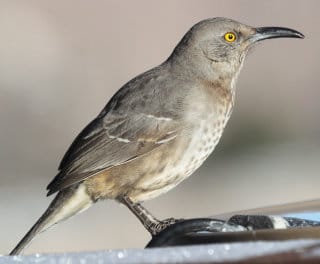 Photo: adult by David Yeamans  Photo: adult by Bob Walker |  Curve-billed ThrasherCBTH (Toxostoma curvirostre, Harporhynchus curvirostris)Family: Mimidae (Mockingbirds, Thrashers, and Allies) Size: 9.5 - 11.5 in (24 - 29 cm) Flies: Jan 01 - Dec 31 Morphology: Similar to adult, but with shorter, straighter bill, yellower eyes, and less obvious spots. Status: native; common Food source: mostly insects and their larvae, as well as spiders, snails, sowbugs, and prickly-pear and saguaro berries Habitat: desert brush, cactus, sagebrush, town Typical location: La Senda, Pajarito Acres The Curve-billed Thrasher is fairly conspicuous due to its habit of dashing about in the open and loudly calling from the tops of small trees. The local area is at the northern edge of its range. These birds forage on the ground, tossing aside litter to find insects. They will also dig in the soil to find food. Curve-billed Thrashers will come to feeders in areas with cholla and sage. The cholla cactus is this bird’s top choice for a nesting site. If the nest is exposed to bright sun, the female will spend time shading the young. There are typically 2 broods and sometimes 3 per year. Info Photos Distribution Frequency |
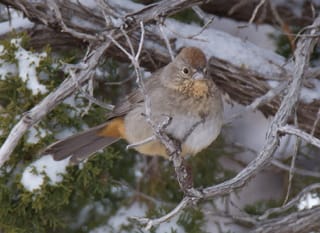 Photo: adult by Greg Lasley 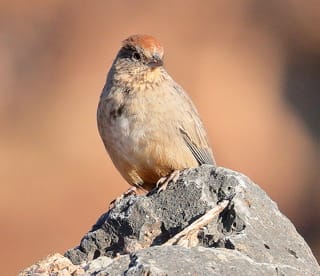 Photo: adult by Bob Walker |  Canyon TowheeCANT (Melozone fusca, Aimophila fuscus)Family: Passerellidae (New World Sparrows and Allies) Size: 8 - 10 in (20 - 25 cm) Flies: Jan 01 - Dec 31 Morphology: large sparrows with long tails and chunky bodies; adults are plain brown overall but have rusty undertail feathers, buffy throats, and reddish crowns Status: native; common Food source: mostly seeds and insects with some berries and small fruits; young fed almost entirely on insects Habitat: bushy and rocky hills in arid country Canyon Towhees can be seen just about everywhere in the local area. They even favor hopping around inside a garage when the door has been left open. They will feed on the insects caught in a car grill and then will hide under the car when disturbed. They prefer to forage under things like logs and scratch in the dirt much less than towhee species do. Canyon Towhees may mate for life and a pair will stay together all year round in a permanent territory. Nests are of a bulky cup design and usually located in a small tree or dense shrub. The young may leave the nest before they can fly, climbing about in the bushes waiting to be fed. It is typical for there to be 2 to 3 broods in a year. Info Photos Distribution Frequency Featured |
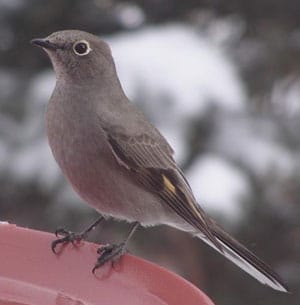 Photo: adult by Dave Yeamans  Photo: adult by Mouser Williams 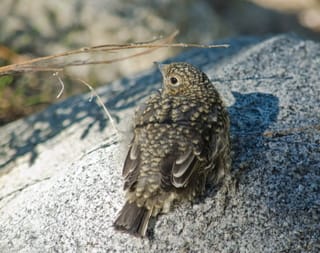 Photo: immature by Frank Fogarty |  Townsend's SolitaireTOSO (Myadestes townsendi)Family: Turdidae (Thrushes) Size: 8 - 9 in (20 - 23 cm) Flies: Jan 01 - Dec 31 Morphology: both sexes are gray with prominent white eye rings, buffy wing patches, and white outer tail feathers; immatures are gray spotted with buff and white Status: native; common Food source: primarily insects, spiders, and other invertebrates in summer and berries ,such as those from juniper and mistletoe in winter Habitat: open coniferous forests, edges, burns Townsend’s Solitaires often sit all alone on an exposed perch for long periods. Their upright posture makes them appear long and slender. They are usually seen in winter when both sexes will defend patches of juniper. These birds typically forage by flying out to catch insects mid-air or by fluttering down to the ground to snatch up food. During breeding season, males will guard the area around the nest by singing either from a high perch on while in flight. Nests are located in a protected spot such as in a shallow depression in a slope or in a crevice. They are of an open-cup design but rather bulky and loosely made. Young probably leave the nest at about 2 weeks of age. Info Photos Range Frequency |
 Photo: male by Bob Walker 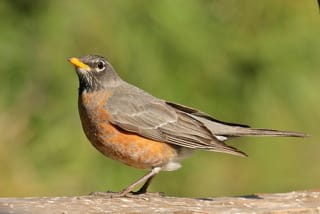 Photo: female by Bob Walker 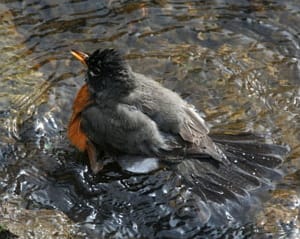 Photo: male bathing by Hari Viswanathan |  American Robin, RobinAMRO (Turdus migratorius)Family: Turdidae (Thrushes) Size: 9 - 11 in (23 - 28 cm) Flies: Jan 01 - Dec 31 Morphology: males are gray-brown with orange underparts and dark heads; females are similar but with paler colors; both sexes have long legs and tail Status: native; common Food source: insects, spiders, berries, earthworms, and snails depending on the time of year Habitat: towns, gardens, open woodlands, coniferous forests in mountains, agricultural areas American Robin are ubiquitous in the area, particularly during summer. This species is the largest North American thrush. Robins forage on the ground, running along or hopping and then pausing when they spot prey. Males will defend nesting grounds before the arrival of females. Females build a nest made of grasses and twigs worked into a foundation of mud. Nests are usually located on a horizontal branch of a tree or shrub. The mother typically lays four “robin’s egg blue” eggs that hatch in 12 to 14 days. The young fledge about 14 to 16 days later. American Robins usually have two broods per season but may have a third. Info Photos Distribution Frequency Featured |
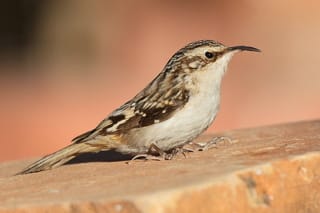 Photo: adult by Bob Walker  Photo: adult by Mouser Williams |  Brown Creeper, American Tree CreeperBRCR (Certhia americana)Family: Certhiidae (Creepers) Size: 5 - 5.8 in (13 - 15 cm) Flies: Jan 01 - Dec 31 Morphology: adults are small and thin with streaked brown and buff coloring above, white underparts, buffy stripe over the eye, long spine-tipped tails, and slender curved beaks; Brown Creepers in Arizona and New Mexico are darker on the back than in other parts of North America Status: native; common Food source: wide variety of insects and spiders, especially eggs and pupae hidden in bark Habitat: deciduous and mixed woodlands Brown Creepers get their common name from their feeding behavior. They “creep” along tree trunks starting at the bottom and moving upward in a spiral looking for food on the bark surface and in crevices. When they reach the top, they will flutter down to the ground and begin all over. These birds will also come to feeders for suet and peanut butter. When threatened, they will freeze using their coloration as effective camouflage. Nests, consisting of a half-cup design, may often be partially hidden in a tree. Info Photos Distribution Frequency |
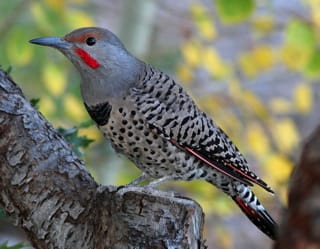 Photo: male by Hari Viswanathan 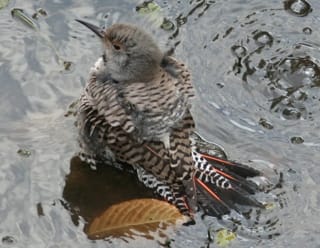 Photo: female by Selvi Viswanathan 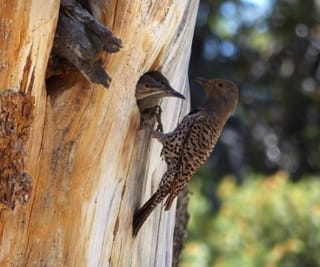 Photo: nest with young by Emma Wynn |  Northern FlickerNOFL (Colaptes auratus)Family: Picidae (Woodpeckers) Size: 12 in (30 cm) Flies: Jan 01 - Dec 31 Morphology: two forms exist with different colored flight-feather shafts (yellow versus red); local adults have red flight-feather shafts, curved bills, stiff tails often used as a prop, brownish bodies with black spots and bars, gray heads, and white rump patches; males have a red mustache stripe; females lack the mustache Status: native; common Food source: insects, including ants, beetles, termites, and caterpillars; will eat fruits, berries, seeds, and nuts at times Habitat: open country with trees, parks, residential areas Northern Flickers are ubiquitous in the local area. They commonly forage by hopping on the ground but also climb trees searching for wood-boring, using their bills to dig the them out. Flickers have sticky, barbed tongues that extends 2 inches beyond their bill for reaching into holes and lapping up food. They will come to feeders for suet and peanut butter. These bird create their nests by chiseling into in dead or dying trees. The cavity nests are used year after year. Eggs are laid in the wood chips at the bottom of the nest. Both parents incubate the eggs and feed the young. The young will stay with their parents for a while after they leave the nest. Info Photos Distribution Frequency Featured |
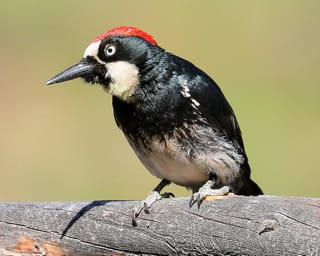 Photo: male by Bob Walker 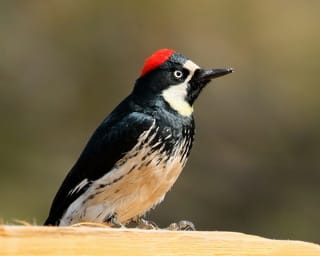 Photo: female by Bob Walker 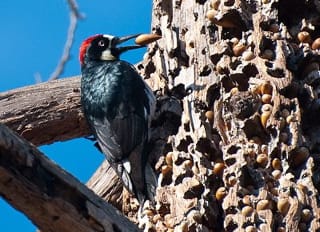 Photo: acorn hoard or granary tree by Johnath |  Acorn WoodpeckerACWO (Melanerpes formicivorus)Family: Picidae (Woodpeckers) Size: 8 - 9.5 in (20 - 24 cm) Flies: Jan 01 - Dec 31 Morphology: both sexes are brownish-black with white eyes and face; the red cap on males starts at the forehead, while the one on females has a black band between it and the face Status: native; locally common Food source: acorns, sap, fruit and insects Habitat: open oak/oak-pine forest Acorn Woodpeckers are most often described as having a clown-like appearance due their brightly covered red, black and white faces. Their flight pattern is distinctive in that they will flap their wings a few times and then drop a foot. As their name implies, acorns make up the majority of their diet. The birds drill numerous holes in dead trees, telephone poles, and wooden buildings to store acorns. Such caches can be used across generations and can be riddled with thousands of holes. In contrast to other woodpeckers, while these woodpeckers eat insects, they rarely dig into wood to find them. Acorn Woodpeckers have a complicated social structure. They live in communal groups consisting of several breeding males and females. The nest consists of a cavity in a tree. Both parents as well as helpers will take turns incubating the eggs. The eggs hatch in a little less than two weeks and fledge at about a month. Parents and helpers take care of the babies. Info Photos Distribution Frequency Featured |
 Photo: adult by Hari Viswanathan 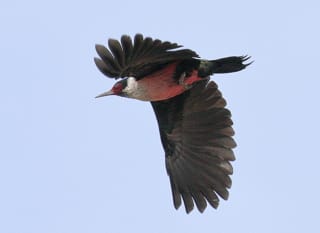 Photo: adult by Bob Walker |  Lewis's WoodpeckerLEWO (Melanerpes lewis, Asyndesmus lewis)Family: Picidae (Woodpeckers) Size: 10.5 - 11.5 in (27 - 29 cm) Flies: Jan 01 - Dec 31 Morphology: adults have oily green back and wings, dark red face, pink belly, and silver-gray collar; immatures are similar but without the red face and gray collar Status: native; locally common Food source: wide variety of insects, nuts, fruits, and berries; young fed on insects Habitat: open pine-oak woodlands, cottonwood groves, ponderosa pine, scattered or logged forest Typical location: Anthony's at the Delta near cottonwood trees Lewis’s Woodpeckers, named for Merriweather Lewis of the Lewis and Clark expedition, are found exclusively in the west. They are rather scarce but can be seen in the area during the fall migration. While these birds climb trees like other woodpeckers, they mostly feed by catching insects mid-air. In addition, they store acorns and other nuts in crevices and guard them as a winter food supply. Pairs can mate for life and use the same cavity nest regularly. Both parents incubate the eggs which hatch in 12 to 16 days. While the young will leave the nest about 4 to 5 weeks after hatching, they will remain in the area with their parents for awhile longer. Info Photos Range Frequency |
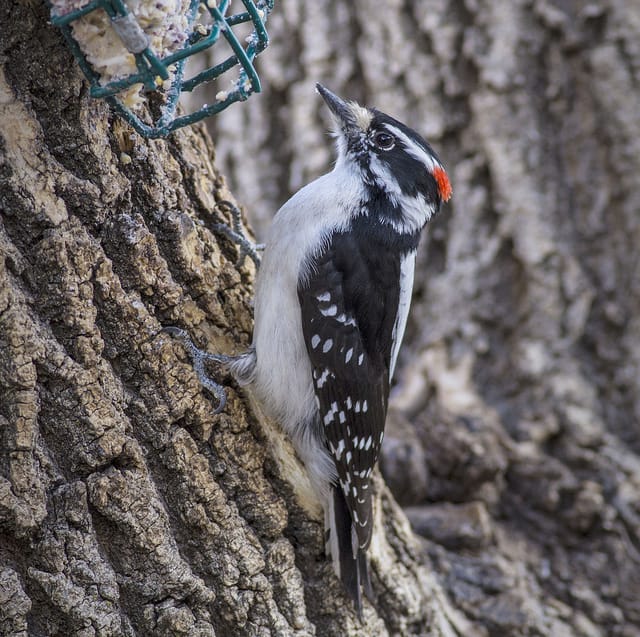 Photo: male by Mouser Williams 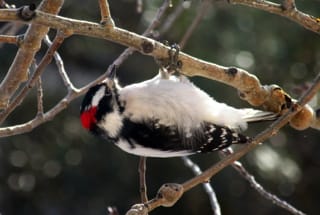 Photo: male by Steve Wagner 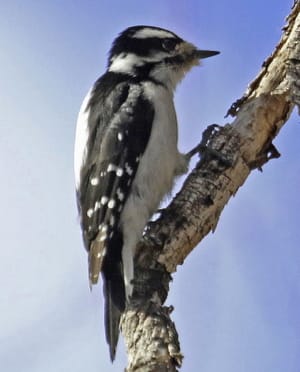 Photo: female by Jerry Oldenettel |  Downy WoodpeckerDOWO (Picoides pubescens, Dendrocopos pubescens)Family: Picidae (Woodpeckers) Size: 6 in (15 cm) Flies: Jan 01 - Dec 31 Morphology: both sexes have black upper parts with white spots on the wings, black and white striped head, small beak, white belly, white stripe down the center of the back, and black spots on a white tail; males have a red patch on the back of the head Status: native; uncommon Food source: mostly insects but will eat some seeds and berries Habitat: woodlands, parks, gardens The Downy Woodpecker appears to be a smaller version of the Hairy Woodpecker. However, the two species are not closely related and do not compete for food. These woodpeckers can be found throughout most of the United States with the exception of desert areas. Downy Woodpeckers are the smallest woodpeckers in North America. Their small size allows them to forage on thin branches, picking at the bark surface. They can often be seen in trees climbing about and even hanging upside down. In addition, these birds will come to feeders for suet and sunflowers. Compared to other woodpeckers, their drumming is rather slow. In fall and winter, males and females feed in separate areas. Pairs come together in late winter attracted by each other’s drumming. Nests consist of a cavity in a dead tree or branch surrounded by fungus or lichen for camouflage. Info Photos Distribution Frequency |
 Photo: male by Dmitry Mozzherin 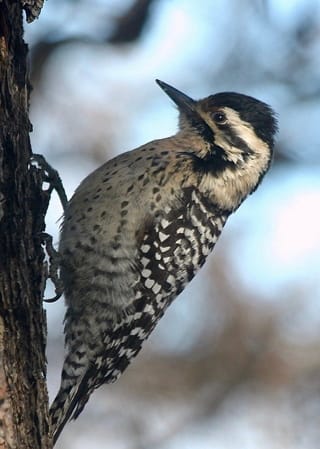 Photo: female by J.N. Stuart 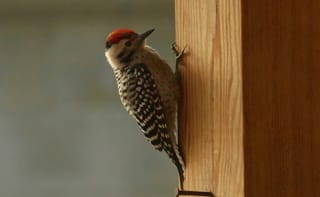 Photo: immature by Mitch Chapman |  Ladder-backed WoodpeckerLBWO (Picoides scalaris, Dendrocopos scalaris)Family: Picidae (Woodpeckers) Size: 7 in (18 cm) Flies: Jan 01 - Dec 31 Morphology: primarily black and white with barred pattern on back and wings along with cream underparts; males have a red cap that extends from nape to mid-crown; females are black from nape to forehead; immatures of both sexes have red crown Status: native; uncommon Food source: variety of insects including beetles and their larvae, caterpillars, true bugs, and ants; eats some fruit and berries including cactus fruit Habitat: arid areas with thickets and trees Typical location: White Rock Canyon The Ladder-backed Woodpecker was once called the Cactus Woodpecker. It most often seen in Texas and Mexico but its overall range includes the local area at its northern edge. These woodpeckers primarily forage in trees, shrubby growth, and tall weeds. Pairs will often forage together focusing on slightly different areas, e.g., trunk versus outer limbs. The Ladder-backed Woodpecker has a distinctive flight pattern: three rapid wing flaps followed by a quick glide with the wings tucked against the body. The nesting site is in a hole in a tree or other plant such as a yucca or even a man-made structure like a fence post. Both parents probably excavate the cavity. Incubation of the eggs is done by both parents and they also both feed the young once hatched. Info Photos Distribution Frequency |
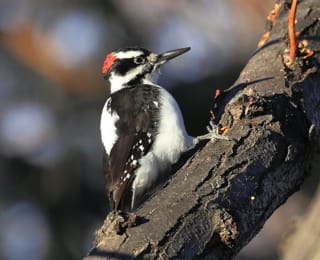 Photo: male by Bob Walker 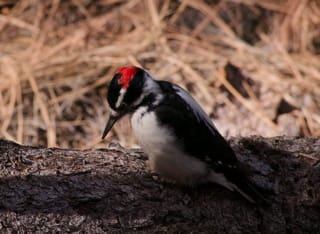 Photo: male by Mitch Chapman 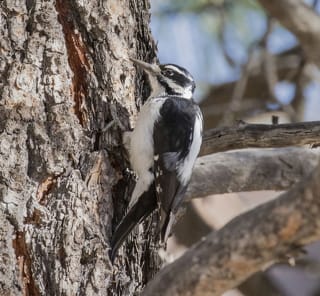 Photo: female by Mouser Williams |  Hairy WoodpeckerHAWO (Picoides villosus, Dendrocopos villosus)Family: Picidae (Woodpeckers) Size: 9 in (23 cm) Flies: Jan 01 - Dec 31 Morphology: both sexes have black upper parts with white spots on the wings, black head with prominent whit stripes, long beak, white belly, a white patch down the center of the back, and pure white tail feathers; males have a red patch on the back of the head Status: native; common Food source: mostly insects but will eat some seeds and berries; will also feed on sap from damaged trees Habitat: deciduous forest The Hairy Woodpecker appears to be a larger version of the Downy Woodpecker. However, the two species are not closely related and do not compete for food. Like other woodpeckers, they have a spongy pad between their bill and skull to protect their brains from the shock of tapping on trees and special feathers around their nostrils to keep out wood chips. A Hairy Woodpecker will tap at a tree truck or major branch, listening for sound differences indicating an insect tunnel. It will then dig away the wood and remove the insect with its long, barbed tongue. These birds are very beneficial, consuming large numbers of wood-boring insects including those in wooden house siding. Hairy Woodpeckers are rather shy but will come to suet feeders. Males and females tend to maintain separate territories but pair up in mid-winter, often with the mate from the previous year. Nests consist of an cavity in an aspen or dead conifer. Info Photos Distribution Frequency |
 Photo: male by Hari Viswanathan 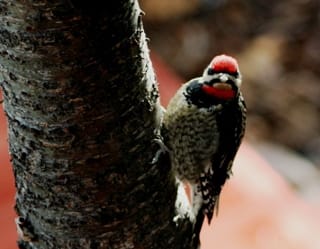 Photo: female by Selvi Viswanathan 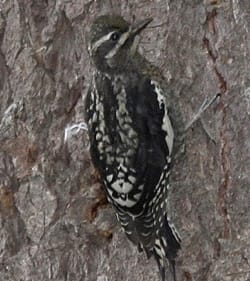 Photo: immature by J.N. Stuart |  Red-naped SapsuckerRNSA (Sphyrapicus nuchalis)Family: Picidae (Woodpeckers) Size: 8 in (20 cm) Flies: Jan 01 - Dec 31 Morphology: birds are mottled black and white overall with a red cap, nape, and throat, a slight peak at the back of the head, a sharp pointed bill, and an elongated appearance due to how they cling vertically to trees; males have a solid red chin but females have a white patch on the chin; immatures have a brown cap and overall brown wash Status: native; uncommon Food source: includes insects, tree sap, berries, and fruit Habitat: edges of coniferous forests, woodlands, gardens, groves of aspen Typical location: Pajarito Ski Hill Parking Lot Red-naped Sapsuckers are often seen during the spring and fall. They drill holes in trees in very neatly spaced rows, leaving the holes to fill up with sap and then returning periodically to drink what has oozed out. In addition, they will take insects from trees like other woodpeckers, including those insects that have become trapped in the sap. Nests are typically found in a tree cavity with the same tree being used several years in a row. These birds prefer trees with heartwood decay which makes it easier to excavate a nesting site. Parents teach the young how to suck sap and take care of them for up to 10 days after they leave the nest. Info Photos Distribution Frequency |
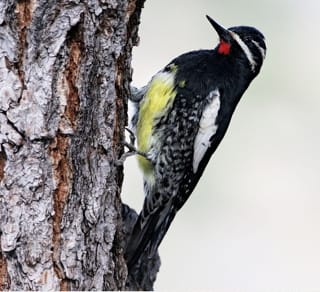 Photo: male by Hari Viswanathan 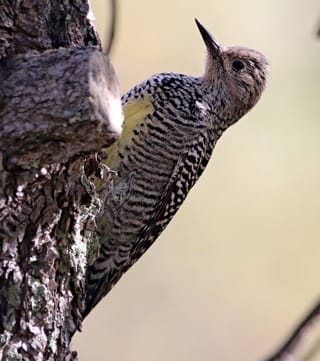 Photo: female by Hari Viswanathan 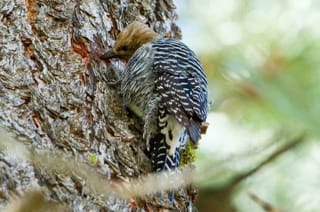 Photo: female by BJ Stacey |  Williamson's SapsuckerWISA (Sphyrapicus thyroideus)Family: Picidae (Woodpeckers) Size: 9.5 in (24 cm) Flies: Jan 01 - Dec 31 Morphology: males are black on the upperparts, head, breast, and tail with a yellow belly, red throat, white rump, white eyestripe and mustache, and a white stripe up the side; females are barred (white, brown, and black) on the upperparts, wings, flanks, tail, and part of the breast along with a brown head, white rump, and yellow belly; immature are like the adults except that males have white throats and nape while females do not have black on the breast Status: native; uncommon Food source: insects (particularly ants), sap, and fruit Habitat: ponderosa pine, coniferous, mixed conifers Male and female Williamson’s Sapsuckers look very different and were once considered to be two separate species with the females named the Black-breasted Woodpecker. Williamson’s Sapsuckers drill small, evenly spaced holes in tree bark in order to allow the sap to ooze out. They will return periodically to feed on the sap. In addition, they will eat a bit of the tree tissue and insects attracted to the sap. The nest site is a cavity in a tree, with one with a dead heartwood but live outer layer preferred. Males may dig new nesting cavities in the same tree year after year. Young leave the nest and the general area at about 3 to 4 weeks after hatching. Info Photos Range Frequency |
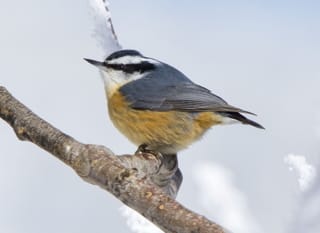 Photo: male by Mouser Williams 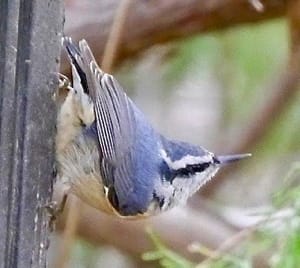 Photo: female by Judith Lopez Sikora |  Red-breasted Nuthatch, Canada NuthatchRBNU (Sitta canadensis)Family: Sittidae (Nuthatches) Size: 4.5 - 4.8 in (11 - 12 cm) Flies: Jan 01 - Dec 31 Morphology: both males and females are blue-gray in color with rusty-colored undersides and a black stripe through the eye; males have a black cap; females have a gray cap with lighter colored undersides Status: native; uncommon Food source: mainly insects and spiders in summer; seeds, often from conifers, in winter; young feed on insects Habitat: coniferous forests primarily in mountainous areas Red-breasted Nuthatches are quiet birds that prefer dense cover so that they are often missed. However, they can be attracted to feeders with sunflower seeds, peanut butter and suet. They can be seen in mixed-species flocks outside the breeding season. Like other nuthatches, these birds are gymnasts. They move rapidly up and down tree trunks and along the undersides of branches looking for food which they may then hoard in a larder. Nests consist of hollowed out cavities which the birds excavate themselves. They smear the entrance with pitch. It has been postulated that this is to deter other creatures. They avoid getting stuck themselves by flying straight into the hole. Incubation time for the eggs is about 12 days with the young leaving the nest 2 to 3 weeks later. Info Photos Distribution Frequency |
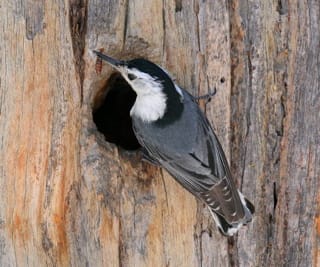 Photo: male by Bob Walker 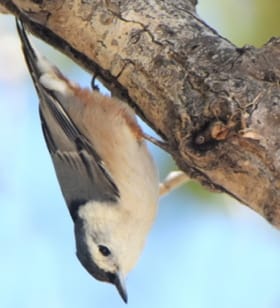 Photo: common foraging position by Steven Mlodinow  Photo: female by Bob Walker |  White-breasted NuthatchWBNU (Sitta carolinensis)Family: Sittidae (Nuthatches) Size: 5 - 6 in (13 - 15 cm) Flies: Jan 01 - Dec 31 Morphology: males have solid back cap with bluish-gray back and wings, white face and white underparts that may have some chestnut color; females are duller than males with a paler cap Status: native; common Food source: variety of insects and seeds Habitat: typically in mature deciduous forest but also in mixed conifer forests White-breasted Nuthatches are common throughout the year in most of the US with several subspecies officially recognized. They are often seen at suet feeders or creeping along tree trunks with their heads down looking for insects in bark crevices. These nuthatches are typically seen singly or in pairs. However, in fall and winter, they will join small mixed-species flocks. Pairs may mate for life and remain in the same area all year round. Nests are built in a cavity from bark fibers, grasses and other materials. Eggs hatch in about two weeks and fledge anywhere from three to four weeks later. Info Photos Distribution Frequency Featured |
 Photo: adult by Bob Walker 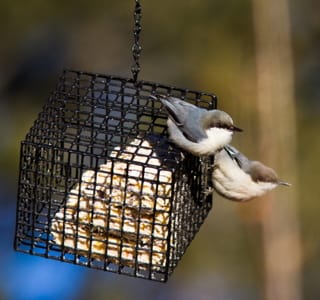 Photo: adult by Cullen Hanks 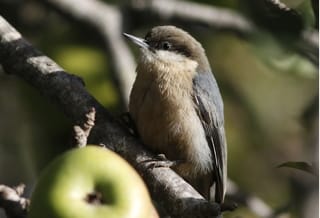 Photo: adult by Donna Pomeroy |  Pygmy NuthatchPYNU (Sitta pygmaea)Family: Sittidae (Nuthatches) Size: 3.8 - 4.5 in (10 - 11 cm) Flies: Jan 01 - Dec 31 Morphology: males and females are similar with slate gray wings and back, a brown cap, and white to buff underparts Status: native; common Food source: primarily insects such as beetles and true bugs in summer; a variety of seeds in winter, especially pine seeds Habitat: pine forests including ponderosa with undergrowth Pygmy Nuthatches are very gregarious, often wandering in noisy flocks and roosting communally. They are also acrobatic, using their sharp claws to help them hop upside down while foraging on the outermost and highest tree branches. These birds are easily attracted to feeders by sunflower seeds, nuts and suet. They often use bark crevices as a place to hold food while breaking it up with their bills. Pygmy Nuthatches nest in cavities in conifers lined with soft materials. A nesting pair may have helpers, usually offspring from a previous year, that aid in defending the territory and raising the young. Eggs are incubated for a little over 2 weeks and the young fledge about 3 weeks later. Info Photos Distribution Frequency |
 Photo: adult by Bob Walker 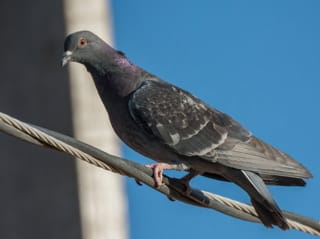 Photo: adult by Marion L. Stelts |  Rock Pigeon, Rock DoveROPI (Columba livia)Family: Columbidae (Pigeons and Doves) Size: 13.5 in (34 cm) Flies: Jan 01 - Dec 31 Morphology: plump bird with small head and short legs; variable in color but most adults are bluish gray with two black bands on the wing, a black tipped tail, and an iridescent band around the throat Status: introduced; common Food source: feeds on waste grain and seeds of many grasses and other plants; in cities will eat bread crumbs, popcorn, and other available junk food Habitat: parks, gardens, farmlands The Rock Pigeon is most often known as the “common city pigeon”. It is originally native to Europe, North Africa, and India but now lives all over the world. It has been domesticated for a variety of purposes: raised for food, trained for racing and carrying messages, and used in research. In many places, though, wild birds frequent both residential and agricultural lands. These pigeons may mate for life. Nests can be found on sheltered cliff ledges or potential substitutes of window ledges or gutters. Young are fed “pigeon milk”, a regurgitated secretion from the crop of the parents. A pair of Rock Pigeons may raise up to 5 broods per year. Info Photos Distribution Frequency |
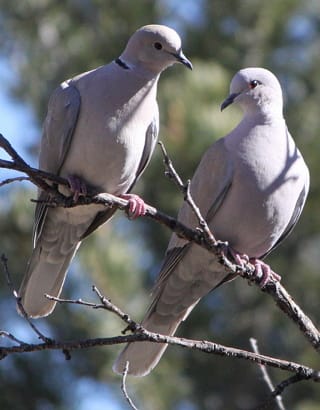 Photo: adult by Dave Yeamans 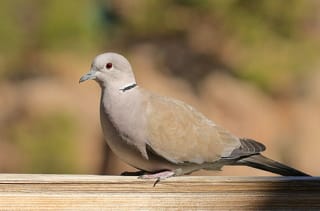 Photo: adult by Bob Walker |  Eurasian Collared-doveEUCD (Streptopelia decaocto)Family: Columbidae (Pigeons and Doves) Size: 13 - 14 in (33 - 36 cm) Flies: Jan 01 - Dec 31 Morphology: adults and immatures look alike and have plump bodies with broad squared off tails; light brown to gray body with white patches on the tail and a narrow black crescent around the nape of the neck Status: introduced; common Food source: mostly seeds with some berries and insects Habitat: small towns, agricultural areas Eurasian Collared-Doves were accidentally introduced into the Bahamas in 1974. Since there they have expanded across most of the US and Mexico. It has been suggested that these birds have been able to exploit a niche made available by the extinction of the Passenger Pigeon. When not breeding, Eurasian Collared-Doves usually forage in flocks on the ground but will come to feeders. These doves can most often be seen in prominent perches. Nests consist of a fragile platform of sticks and twigs. There are usually only one or two eggs. However, in some areas there are reports of up to six broods per year. Info Photos Distribution Frequency Featured |
 Photo: adult by Bob Walker 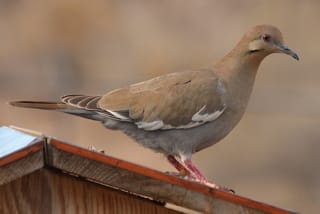 Photo: adult by J.N. Stuart 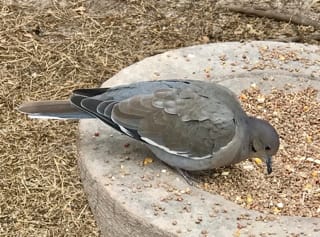 Photo: adult by CK Kelly |  White-winged DoveWWDO (Zenaida asiatica)Family: Columbidae (Pigeons and Doves) Size: 12 in (30 cm) Flies: Jan 01 - Dec 31 Morphology: plump, square-tailed birds with long bills; adults are brown overall with white stripes at the edge of the wings, white-tipped tails with black stripes, a black streak across each cheek, and blue skin around red eyes Status: native; common Food source: mostly seed from wild plants and cultivated grains; will also eat fruits and berries as well as nectar from large flowers Habitat: open country with dense thickets of shrubs and low trees The White-winged Dove, related to the Mourning Dove, is most common in the southwest, but its range is currently expanding across the US and into Canada. These birds are often seen at platform feeder, but mostly forage on the ground. They will also feed in trees, shrubs, and large cacti. In areas with giant saguaro cacti, these doves are important pollinators. Both members of a pair go through a courting ritual consisting of nodding and preening motions. The nest is a flimsy platform made of sticks placed in a tree, shrub, or cactus. Both parents feed the young “pigeon milk” which consists of a secretion from the lining of the parent’s crop. There are typically 2 to 3 broods per year. Info Photos Distribution Frequency |
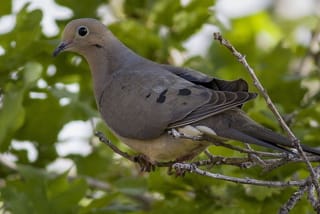 Photo: adult by Mouser Williams 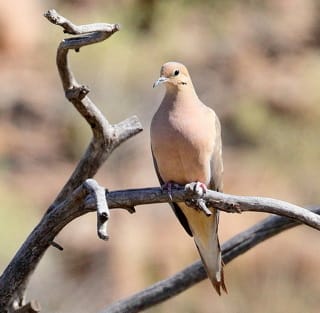 Photo: adult by Bob Walker  Photo: nest by J.N. Stuart |  Mourning DoveMODO (Zenaida macroura, Zenaida carolinensis)Family: Columbidae (Pigeons and Doves) Size: 12 in (30 cm) Flies: Jan 01 - Dec 31 Morphology: plump-bodied bird with small head and long, pointed tail; adults are brown to buffy-tan overall with black spots on the wings and white tipped, black-bordered tail feathers Status: native; common Food source: feeds almost exclusively on seeds Habitat: open fields, parks, lawns with many trees and shrubs Ubiquitous. One of the most common birds in the county. When they take flight, the wings make a whistling noise. Info Photos Distribution Frequency |
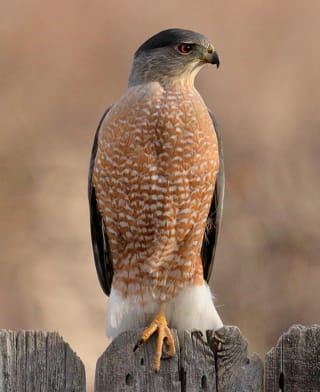 Photo: adult by Bob Walker 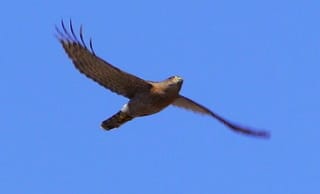 Photo: adult by Judith Lopez Sikora 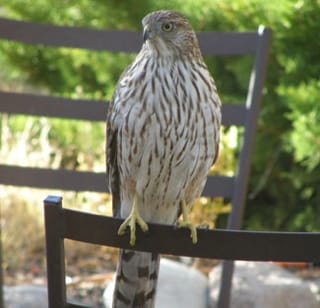 Photo: immature by Chick Keller |  Cooper's HawkCOHA (Accipiter cooperii)Family: Accipitridae (Hawks and Eagles) Size: 14 - 21 in (36 - 53 cm) Flies: Jan 01 - Dec 31 Morphology: looks like a Sharp-shinned hawk but larger; adults of both sexes are blue-gray above with reddish bars on the breast; females are larger than males; young birds are brown above, streaked with brown on the breast, and have yellow eyes Status: native; common Food source: mostly birds and mammals; occasionally reptiles and insects Habitat: forests, especially those interrupted by clearings; currently entering more suburban and urban areas Typical location: Bandelier Cooper’s Hawks have short rounded wings, long tails and small hooked beaks. In flight, they have a long-necked appearance, often referred to as a “flying cross”. They typically use quick, consecutive wing beats and a short glide. They use stealth to capture prey either by swooping down from cover or by flying quickly through dense vegetation. Studies have shown that the later technique, while successful, can be dangerous resulting in broken chest bones. Prey is captured with the bird’s feet. Females build nests high up in trees usually on a foundation of a preexisting nest. The eggs are incubated for a little over a month. The young will climb around the nest tree at about four weeks of age. They will be able to fly soon thereafter, but will stay with their parents for another month. Info Photos Range Frequency |
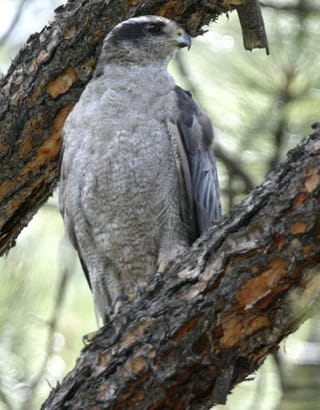 Photo: Richard Reynolds 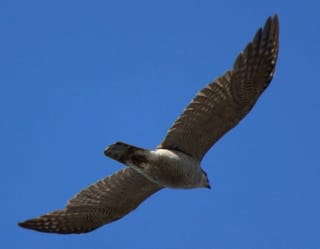 Photo: adult by scops 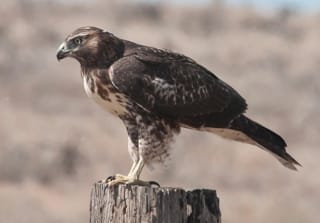 Photo: immature by Marion L. Stelts |  Northern GoshawkNOGO (Accipiter gentilis)Family: Accipitridae (Hawks and Eagles) Size: 20 - 26 in (51 - 66 cm) Flies: Jan 01 - Dec 31 Morphology: adults are dark slate gray above and paler underneath with a dark head and white stripe over the eye; females are larger than males; immatures are brown and streaky with dark tail bands and yellow eyes Status: native; locally common Food source: mostly birds and small mammals such as grouse and squirrels; also eats snakes and some insects Habitat: forests (deciduous and coniferous) with intermediate to heavy canopy coverage, scrub, farmlands, woodland edges The Northern Goshawk has a relatively short, broad wings, a long tail and a relatively large bill. It is an expert at the surprise attack and prefers to hunt by watching for prey perched quietly about half-way up a tree, often moving from one perch to another. When prey is spotted, the bird will put on an extra burst of speed, plunging through tangled branches in pursuit. Goshawks only vocalize during breeding and nesting season. When calling while perched, the birds often move their heads from side-to-side to throw the sound. Males provide food for the nesting females starting before the eggs are laid. Nests are built in a major fork up in a tree. They are often reused so that more material is added each year making the them quite large. Both parents will boldly defend the nest, diving and nipping at intruders including humans. Eggs hatch approximately 35 days after laying and the young fledge at 5 to 6 weeks. Info Photos Distribution Frequency |
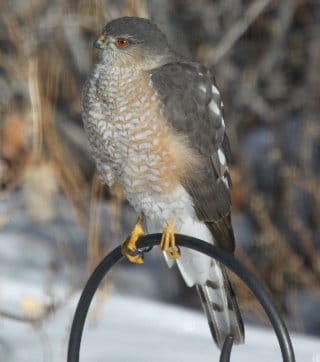 Photo: adult by David Yeamans 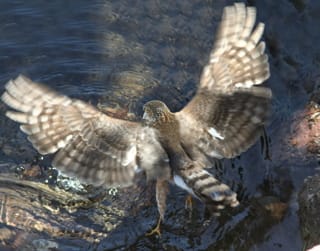 Photo: adult by Hari Viswanthan 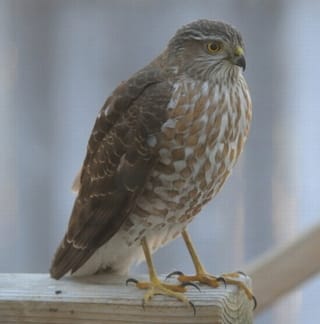 Photo: immature by Marion L. Stelts |  Sharp-shinned HawkSSHA (Accipiter striatus)Family: Accipitridae (Hawks and Eagles) Size: 10 - 14 in (25 - 36 cm) Flies: Jan 01 - Dec 31 Morphology: adults are dark blue-gray to brown above with horizontal red-orange bars on the breast; females are larger than males; immatures are similar to the adults but with brown vertical streaks on the breast and yellow eyes Status: native; common Food source: mostly small birds such as sparrows; rarely will eat rodents, bats, squirrels, lizards, frogs, snakes, and large insects Habitat: coniferous and deciduous woodlands with dense cover Typical location: Barranca Canyon, Deer Trap Mesa One of the smallest and most numerous of hawks, the Sharp-shinned Hawk lives in the local area year round but is most often seen when migrating populations pass overhead. It mostly hunts by perching inside foliage and waiting for smaller birds to come close. Then with a burst of speed, it will fly out and capture its prey. Sharp-shinned will target groups of smaller birds by lying in wait at backyard bird feeders. The nest is a platform of sticks lined with softer material and located in dense cover. Egg incubation time is 30 to 35 days. Females staying near the young for the first few weeks while the males bring food. The chicks will start to move around the nest tree at about 3 to 4 weeks of age and will be able to fly at 5 to 6 weeks. Info Photos Distribution Frequency |
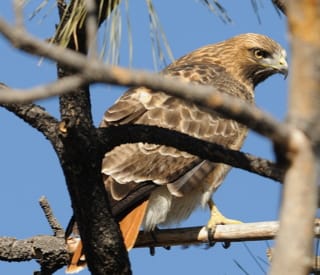 Photo: adult by Marion Stelts 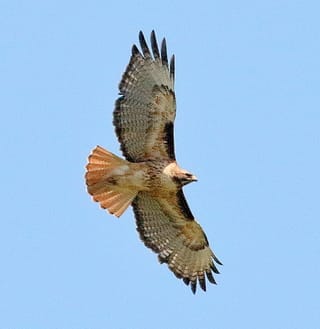 Photo: adult by Bob Walker 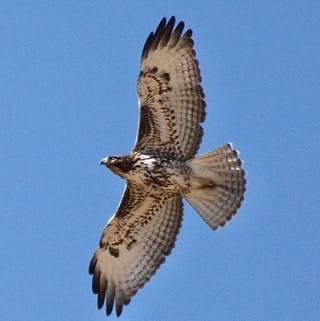 Photo: immature by J.N. Stuart |  Red-tailed Hawk, ChickenhawkRTHA (Buteo jamaicensis)Family: Accipitridae (Hawks and Eagles) Size: 18 - 25 in (46 - 64 cm) Flies: Jan 01 - Dec 31 Morphology: females larger than males; large amount of variability in overall color depending on subspecies and region (light, intermediate and dark); young birds have mottled white patches on back and brown tail Status: native; common Food source: small mammals (voles, rats, rabbits, and ground squirrels), birds, and reptiles (especially snakes) Habitat: forests, open country, agricultural field and urban areas Typical location: Los Alamos Airport The Red-tailed Hawk is the common hawk in the area. It can be seen flying overhead with slow, measured wing beats or soaring upward doing slow turns. It often perches next to highways looking for prey. The birds mate in spring and build a nest made of sticks lined with soft materials. Nests are usually located high up in a tree or on a cliff ledge. However, they can also be found on high buildings or towers. The females lay from 1 to 5 eggs which hatch in about a month. The babies fledge at around 6 to 7 weeks old but will stay with their parents for a few weeks longer. Info Photos Distribution Frequency |
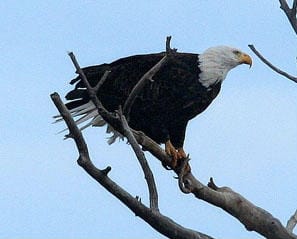 Photo: adult by Hari Viswanathan 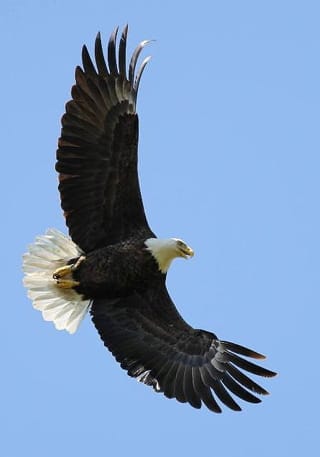 Photo: adult by Tim Kaufman 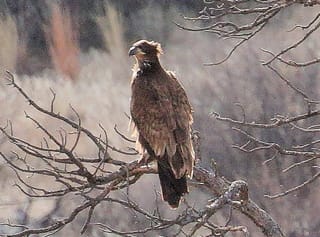 Photo: immature by Bob Walker |  Bald EagleBAEA (Haliaeetus leucocephalus)Family: Accipitridae (Hawks and Eagles) Size: 30 - 31 in (76 - 79 cm) Flies: Dec 15 - Mar 15 Morphology: adults have dark brown bodies and wings with white heads and tails; females are larger than males; immature birds are brown all over with white mottling on their wings and bodies Status: native; uncommon; threatened Food source: fish make up a large part of the diet; also eat birds, reptiles, amphibians, invertebrates, medium-sized mammals, and carrion Habitat: lakes, rivers, marshes Typical location: White Rock Canyon The Bald Eagle is a large impressive bird with very acute eyesight, extremely sharp talons that can be used to kill, and a hooked beak that can rip flesh. These eagles are fast fliers, using thermal convention currents to soar above the canyons. They often hunt from a high perch, swooping down to catch prey in their talons. Alternatively, they may fly low over the ground or water looking for food. The Bald Eagle nest is the largest of any North American bird. Eggs are laid in mid-February and they hatch in mid-April to early May. The young fledge in late June to early July but are not sexually mature for another four to five years. The Bald Eagle is both the national bird and national animal of the US. It was once endangered but has since been moved to the list of locally threatened species. Info Photos Distribution Frequency |
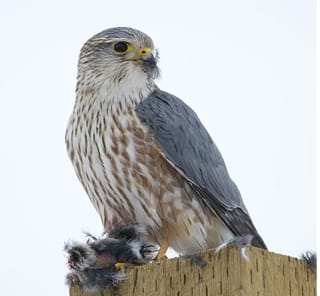 Photo: male by Raj Boora 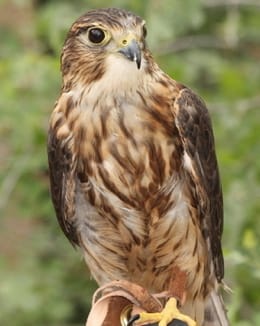 Photo: female by J.N. Stuart  Photo: female by Sandra Cote |  MerlinMERL (Falco columbarius)Family: Falconidae (Caracaras and Falcons) Size: 10 - 14 in (25 - 36 cm) Flies: Oct 15 - Apr 15 Morphology: males have blue-gray backs; females and immatures are browner; all have streaked chest, dark underwings, and white stripes on the tail Status: native; uncommon Food source: mostly small, plentiful birds like house sparrows; will eat bats, large insects, small rodents, and reptiles Habitat: pine forests One of the smallest falcons, the Merlin, is a migrant that spends its winter in the area. The overall North American population of Merlins is increasing as the bird is adapting to urban areas. The Merlin prefers to hunt from a perch and will fly out to capture a songbird in mid-air. Alternatively, it will fly low over the ground moving quickly to surprise its prey. Merlins typically take over old nests of hawks or crows and usually do not redecorate. The female tends the eggs until they hatch at about 4 weeks and then takes care of the baby birds while they are small. The male brings food. The chicks usually are ready for their first flight at about one month of age. Info Photos Distribution Frequency |
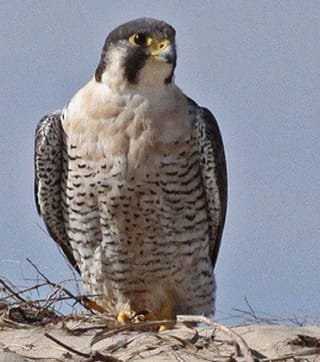 Photo: adult by Jerry Oldenettel 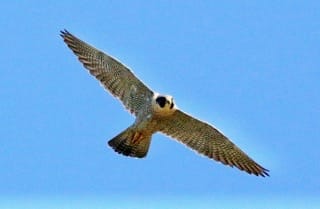 Photo: adult by Bob Walker 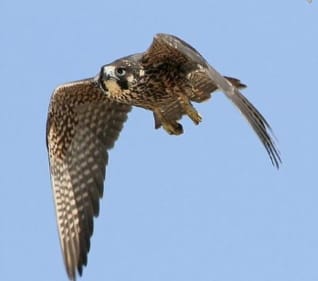 Photo: immature by NMH Citizen Science Program |  Peregrine FalconPEFA (Falco peregrinus)Family: Falconidae (Caracaras and Falcons) Size: 15 - 21 in (38 - 53 cm) Flies: Jan 01 - Dec 31 Morphology: adults are dark blue-gray above with horizontal bars on underparts and a dark head; females are larger than males; immatures similar to adults but with vertical streaks on the breast Status: native; uncommon Food source: mostly birds such as pigeons and ducks; occasionally eats bats Habitat: open country,especially along rivers and near lakes; has moved into urban areas The Peregrine Falcon is one of the world’s fastest birds. Peregrines are often seen flying in the wild in canyons. While hunting these birds soar very high and then precipitously dive at speeds over 200 mph (320 km/h) to capture their prey mid-air. Larger birds are knocked out of the sky and then eaten on the ground where they fall. Peregrines have several special adaptations that allow them to survive the pressure of these spectacular dives. They have long been a favorite of falconers due both to this athleticism and the ease with which they can be trained. Peregrines were once on the decline due to the effect of pesticides but are currently making a comeback. Nests are usually found on a cliff lee. However, sometimes they are seen in a tree, on the ground on a hilltop, or on man-made structures. Females incubate the eggs for about a month while the male feds the female. The young are able to fly at 6 to 7 weeks. Info Photos Distribution Frequency |
 Photo: male by J.N. Stuart 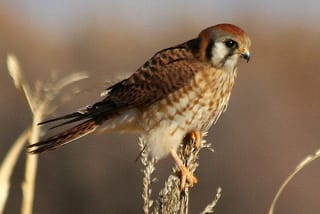 Photo: female by J.N. Stuart 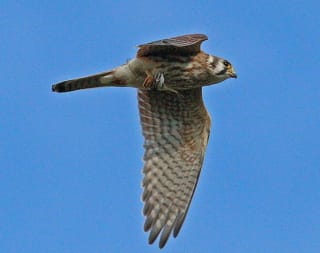 Photo: Jerry Oldenettel |  American KestrelAMKE (Falco sparverius)Family: Falconidae (Caracaras and Falcons) Size: 9 - 12 in (23 - 30 cm) Flies: Jan 01 - Dec 31 Morphology: males have blue-grey wings, white undersides, and rufous back; females have rufous backs and wings with brown bars and cream undersides; young are similar in plumage to adults Status: native; common Food source: mostly large insects, in particular grasshoppers, but also some small mammals, bird and lizards Habitat: towns, parks, farmlands, any kind of open or semi-open situation The American Kestrel is the smallest falcon in North America and the most common. It is leaner and more muscular than larger falcons with long, narrow wings that taper to a point. Given their small size, kestrels are often used in falconry, particularly by beginners. Kestrels primarily hunt from a perching position where they scan the ground for prey. They are commonly seen perched on wires and other high places along the roadside. However, they may hover over a field when a good perch is not available. The birds builds nests fairly high above the ground in cavities in trees, cliffs, buildings, and other structures. Both sexes help to incubate the eggs which hatch in about one month. The young fledge about a month later. Info Photos Distribution Frequency |
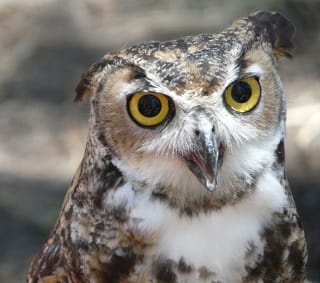 Photo: adult by Thomas Shankland 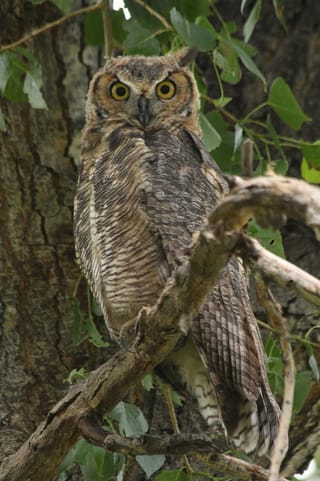 Photo: adult by J.N. Stuart 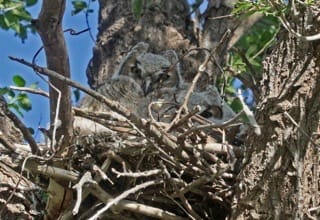 Photo: nest with young by Jerry Oldenettel |  Great Horned Owl, Hoot OwlGHOW (Bubo virginianus)Family: Strigidae (Owls) Size: 25 in (64 cm) Flies: Jan 01 - Dec 31 Morphology: both sexes are mottled gray-brown with a reddish face, white patch on the throat, and two prominent feathered tufts on the head; birds in the Southwest are paler and grayer than elsewhere Status: native; common Food source: mostly eats mammals (rats, mice, rabbits, squirrels, skunks, etc.) and birds ranging in size from kinglets to herons; will also eat snakes and lizards Habitat: wooded areas with fields or other open areas The Great Horned Owl is a large bird that is aggressive and powerful, earning it the nickname of “Tiger Owl”. These birds have extremely good hearing and vision. They hunt mostly at dusk and after dark. They will watch from a high perch and then swoop down capturing prey in their talons. During northern winters, they may let uneaten prey freeze, only to come back later and thaw it out using their own body heat. Nesting may begin as early as late winter in some areas. This potentially allows the young to have enough time to learn hunting skills before the next winter. Nests are often those of other large birds with the addition of a few new feathers. The young will leave the nest at about 5 weeks old but cannot fly until 9 to 10 weeks of age. The parents may continue to fed the young for several months more. Info Photos Distribution Frequency |
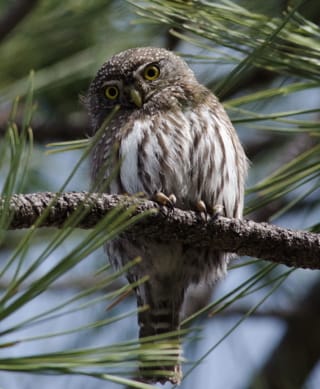 Photo: adult by Gordon Karre 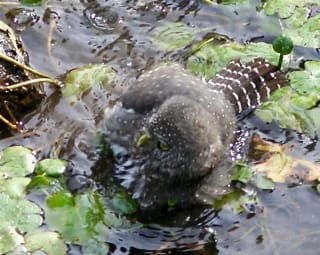 Photo: adult by Selvi Viswanathan 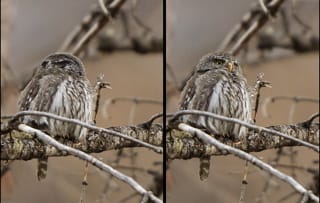 Photo: back and front of head by Mouser Williams |  Northern Pygmy-Owl, Mountain Pygmy-OwlNOPO (Glaucidium gnoma)Family: Strigidae (Owls) Size: 6.3 - 7.1 in (16 - 18 cm) Flies: Jan 01 - Dec 31 Morphology: adults are brown overall with fine white spots on head and back and white stripes on tail; they lack ear tufts but have two dark patches on the back of the neck that look like eyespots Status: native; uncommon Food source: will eat rodents, birds, insects and lizards; prefers songbirds Habitat: open coniferous and mixed forests, open fields, and wetlands Typical location: Bandelier, Upper Canyons Northern Pygmy-Owls are very small and are often active during the day. They will wait quietly to spot their prey and then fly fast and low to grab their target. They can carry more than twice their own weight. These birds are aggressive and catch more birds than most small owls. In defense, gangs of songbirds, in particular chickadees, will often gather to “mob” a Northern Pygmy-Owl. During courtship, pairs will rapidly chase each other near potential nesting sites. They nest in tree cavities, often using old woodpecker holes and defend large territories during breeding season. Info Photos Distribution Frequency |
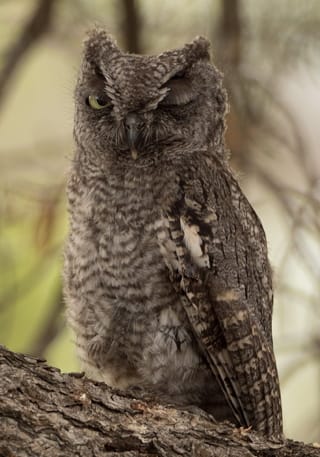 Photo: Corry Clinton  Photo: Shravans14 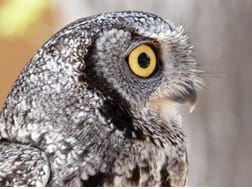 Photo: Sally King, NPS |  Western Screech-OwlWESO (Megascops kennicottii)Family: Strigidae (Owls) Size: 7 - 10 in (18 - 25 cm) Flies: Jan 01 - Dec 31 Morphology: round head with ear tufts, yellow eyes, and yellowish bill; there are several morphs that range in color from brown to dark gray with streaked underparts; females are larger than males Status: native; common Food source: small mammals and large insects Habitat: wooded canyons, desert scrubland and farm groves The Western Screech Owl is a small, inconspicuous but fairly common owl found in many different habitats throughout the western US. Its call is not actually a screech, but more a series of short hoots at increasing tempo. Like other owls, it forages at night, hunting mostly from a perch from which it swoops down to take prey. It locates prey by both sight and sound. Western Screech Owls nest in a cavity in a tree or pole, often in an old woodpecker hole. The top photo was taken of an owl that was rescued after finding its way down a chimney. The female incubates the eggs for a little less than a month and the young fledge at about 4 weeks of age. However, both parents will take care of the young for awhile longer. Info Photos Distribution Frequency |
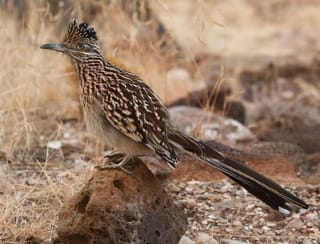 Photo: adult by Stephen Shankland 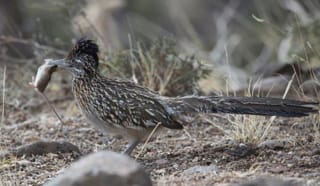 Photo: adult by George Caleff 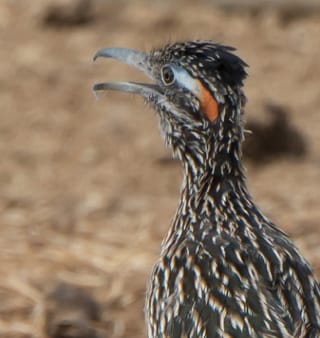 Photo: adult displaying by Marion L. Stelts |  Greater Roadrunner, Chapparal CockGRRO (Geococcyx californianus)Family: Cuculidae (Cuckoos and Roadrunners) Size: 24 in (61 cm) Flies: Jan 01 - Dec 31 Morphology: both sexes are tan with black streaks and long legs, tails, and necks; they have down-curved bills, a short crest on the head, and a patch of bare, blue skin behind each eye Status: native; uncommon Food source: insects, reptiles, rodents, and birds Habitat: open arid country with scattered thickets Typical location: White Rock Canyon Fairly common in around the canyon rim. They are often present near feeders not to eat the seed but to ambush other birds. Info Photos Distribution Frequency |
 Photo: male by Hari Viswanathan 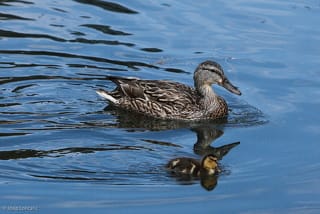 Photo: female with duckling by Josip Loncaric 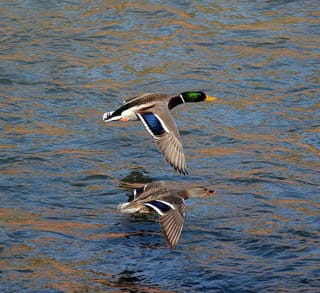 Photo: female and male by Kevin Arceneaux |  MallardMALL (Anas platyrhynchos)Family: Anatidae (Ducks and Geese) Size: 18 - 27 in (46 - 69 cm) Flies: Jan 01 - Dec 31 Morphology: males have a brown breast, black back, iridescent green head, and yellow bill; females and immatures are mottled brown with brown to orange bills; both sexes have blue patch in the wing Status: native; locally common Food source: eats mainly plant material including seeds, stems, and roots along with insects, mollusks, crustaceans, and small fish; ducklings mostly eat aquatic insects Habitat: marshy areas Typical location: Bandelier Sewage Lagoons, Rio Grande The Mallard is the most well known of wild ducks and the ancestor of most strains of domesticated ducks. Mallards are dabbling ducks, meaning that they usually feed either on the surface of shallow water or tip headfirst into the water to find aquatic vegetation and insects. Pairs form in fall and winter and seek a nesting site together. The nest, consisting of plant material lined with down, may be some distance from water but is usually on the ground concealed by vegetation. Young leave the nest within day of hatching and are able swim and feed themselves immediately. Tracks Info Photos Distribution Frequency |
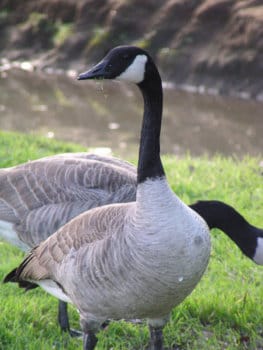 Photo: adult by Akkana Peck 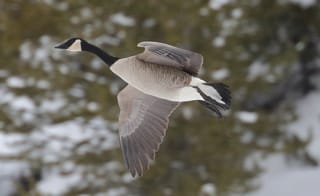 Photo: adult by Bob Walker 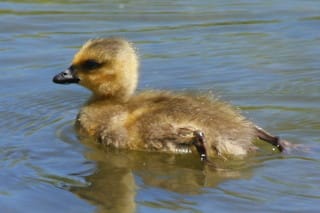 Photo: gosling by J.N. Stuart |  Canada GooseCANG (Branta canadensis)Family: Anatidae (Ducks and Geese) Size: 35 - 45 in (89 - 114 cm) Flies: Jan 01 - Dec 31 Morphology: both sexes have a black head with white cheeks and chinstrap, black neck, tan breast, and brown back Status: native; uncommon Food source: feeds on a wide variety of plants including aquatic plants; eats seeds and berries along with some insects and small fish Habitat: lakes, bays, rivers, marshes, open grassy areas Typical location: Rio Grande Canada Geese are known for their V-shaped migrating flocks and can be seen flying overheard. There are several subspecies that vary in size and calls. They mostly forage in flocks, grazing while walking on land but will also feed in water, sometimes up-ending but usually only submerging head and neck. They have adapted well to being around man, favoring the areas around park ponds and golf courses. This had caused them to be a nuisance in some areas. Canada Geese may mate for life. The female choses the site, usually on slightly elevated dry ground near water, while the male defends the territory. The nest consists of a shallow bowl lined with sticks, etc. in a slight depression. Young are lead away from the nest a day or so after hatching. They feed themselves from then on but are tended by both parents until first flight, usually at 7 to 9 weeks of age. Tracks Info Photos Distribution Frequency |
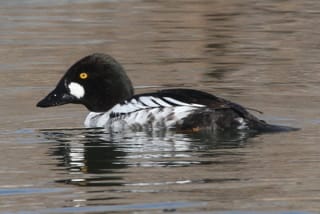 Photo: male by J.N. Stuart 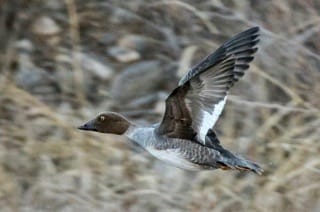 Photo: female by Mouser Williams 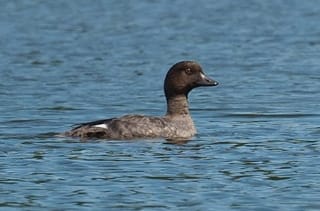 Photo: immature by Jakob Fahr |  Common GoldeneyeCOGO (Bucephala clangula)Family: Anatidae (Ducks and Geese) Size: 16 - 20 in (41 - 51 cm) Flies: Nov 17 - Mar 07 Morphology: medium-sized duck that has a large head, small, narrow bill, and a large white patch in the wings that shows during flight; males are mostly black and white with a round spot near a black bill and bright yellow eyes; females have brown heads, gray backs and wings, and yellow eyes; immatures are similar to females except for dark eyes Status: native; locally common Food source: eats crustaceans, small fish, aquatic insects, and some plant material; diet varies with seasons Habitat: wooded lakes,ponds Typical location: Rio Grande Common Goldeneyes are robust diving ducks that mostly forage underwater and are capable of diving to depths of 20 feet (6 meters). These birds are often seen in flocks and, when feeding, all of the birds in one area may dive at the same time. Pairs usually form in late winter. Females often return year-after-year to the site where they hatched. Nests are typically in tree cavities high above the ground. Young leave the nest a day or two after hatching and are led to water by the female. They can fed themselves immediately but are unable to fly until about 2 months old. Tracks Info Photos Distribution Frequency |
 Photo: male by Jerry Oldenettel 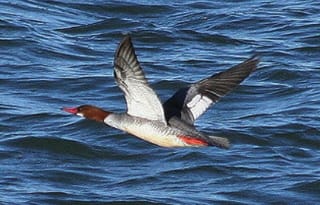 Photo: female by Mouser Williams 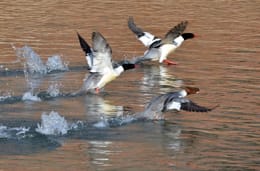 Photo: males and female by Kevin Arceneaux |  Common Merganser, GoosanderCOME (Mergus merganser)Family: Anatidae (Ducks and Geese) Size: 22 - 27 in (56 - 69 cm) Flies: Dec 07 - Mar 15 Morphology: both sexes are long-bodied with thin, pointed wings and straight, narrow bills; males have white bodies, iridescent green heads, black backs, and red bills; females have gray bodies with a white chest and rust-colored heads with a shaggy crest on the back of the head Status: native; locally common Food source: adults eat mostly fish but will eat mussels, shrimp, salamanders and rarely plant material; young eat aquatic insects Habitat: along water ways Typical location: Rio Grande The Common Merganser is the largest of the three mergansers in North America. While these birds may swim on the water surface looking for food, they are “divers”, completely going underwater to obtain their prey. Their bills have serrated edges that helps them grip fish and other small animals. During courting, a male will swim very rapidly in circles near a female and then stretch its neck up and give a light call. Nests, made of wood chips or other debris, are located near water in a cavity or crevice. Young leave the nest a day or two after hatching by jumping from the nest to the ground. They can feed themselves right away but cannot fly for about two months. Tracks Info Photos Distribution Frequency |
 Photo: adult by Mike Baird 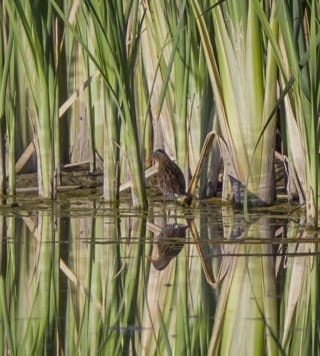 Photo: adult by Mouser Williams  Photo: immature by Joanne Redwood |  Virginia RailVIRA (Rallus limicola)Family: Raillidae (Cranes and Rails) Size: 9 - 11 in (23 - 28 cm) Flies: Jan 01 - Dec 31 Morphology: adults are rusty colored overall with a a gray face, long red bill, upturned tail, black-and-white barring on the sides, and red legs; immatures are covered in black down Status: native; uncommon Food source: eats mostly insects (often aquatic insects and their larvae), crayfish, snails and some seeds Habitat: freshwater and brackish marshes Typical location: Pajarito Wetlands closed to the public Virginia Rails are shy, being heard more often than seen. They prefer to run, even through dense vegetation, rather than fly. These birds forage by probing the mud or shallow water for small creatures or by picking them up off the ground or from plants. Courtship consist of the male running back and forth with wings raised in front the female followed by the pair bowing to each other. Nests are usually placed in a wet area over very shallow water. They consist of a platform made up of cattails, reeds, and grasses usually with a canopy of living plants over top. The young leave the nest soon after hatching. Chicks are able to feed themselves at 2 to 3 weeks of age and are able to fly around soon thereafter. Info Photos Distribution Frequency |
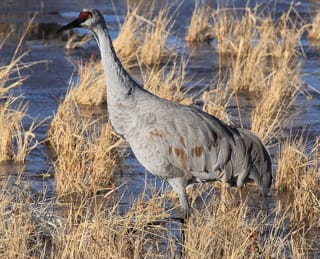 Photo: adult by Josip Loncaric 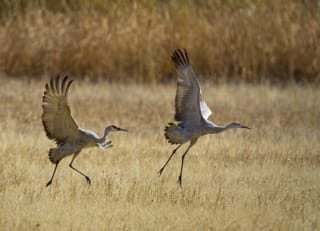 Photo: adult chasing immature by Mouser Williams 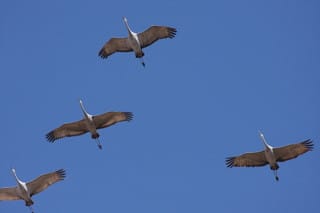 Photo: adults by J.N. Stuart |  Sandhill Crane, Florida CraneSACR (Grus canadensis)Family: Gruidae (Cranes and Rails) Size: 34 - 48 in (86 - 122 cm) Flies: Feb 01 - Apr 07 and Oct 01 - Dec 31 Morphology: slate gray birds with bulky bodies, slender necks, small head, long bills, and short tails with drooping feathers that look like a bustle; adults have pale checks and red skin on the crown; immatures lack the pale check and red crown Status: native; locally common Food source: insects, roots of aquatic plants; rodents, snails, frogs, lizards, snakes, nestling birds, berries, and seeds depending on the location and season Habitat: large freshwater marshes, prairie ponds, marshy tundra Sandhill Cranes can regularly be seen flying far over head during the fall migration. They are abundant at Bosque del Apache in winter where they forage in flocks in the open fields. Courtship for these cranes includes several different “dances”, consisting of leaping in the air with wings spread while calling. There are two versions designed to attract a mate and three others to strengthen and maintain the pair bond. Nests which consist of a mound of plant material are usually located in marshy areas or on the ground near water. Young leave the nest within a day of hatching but are tended by both parents until they are able to feed themselves. First flight is at about 70 days of age. However, the young will remain with their parents for some time, accompanying them during migration. Info Photos Distribution Frequency |
